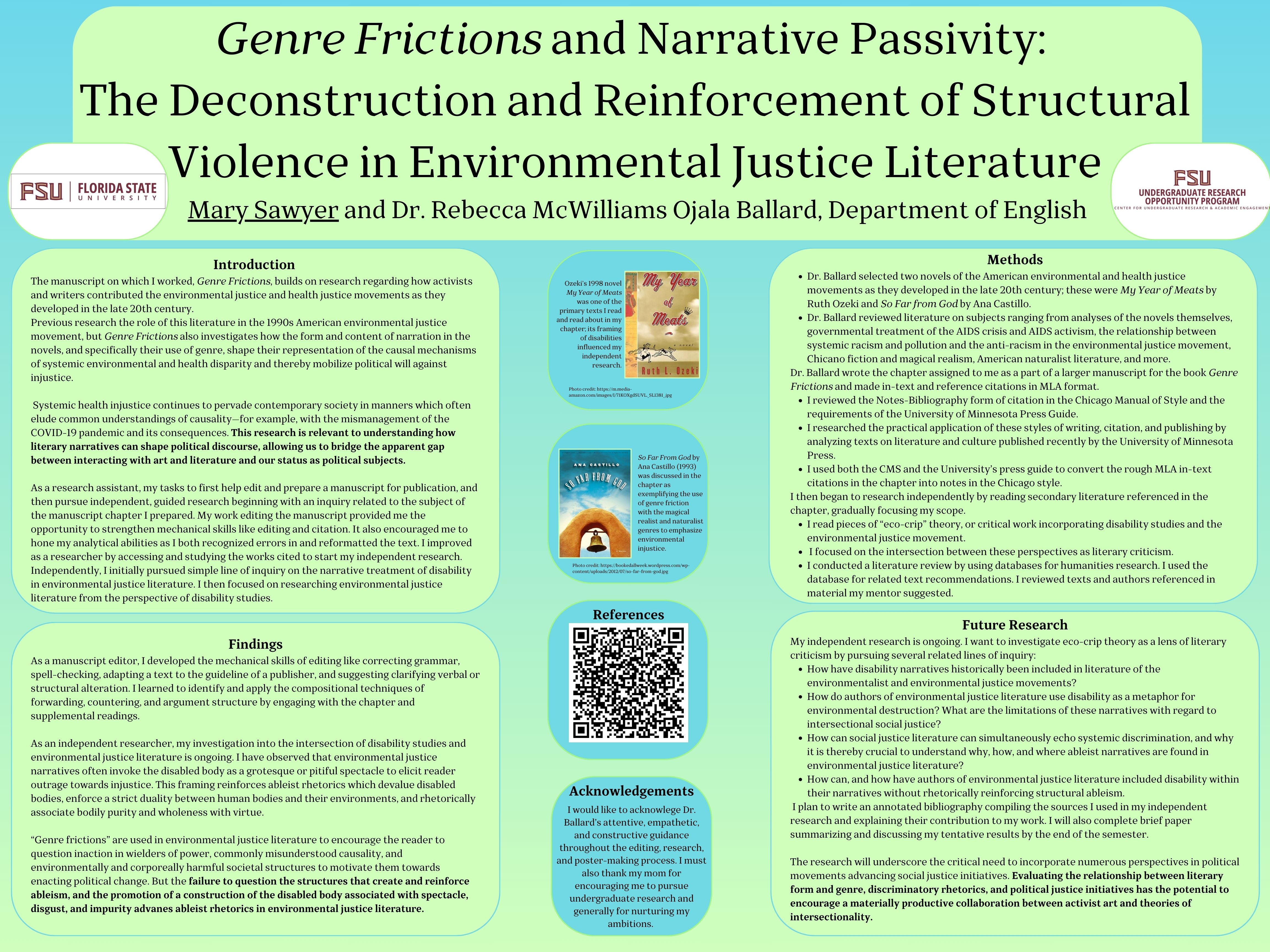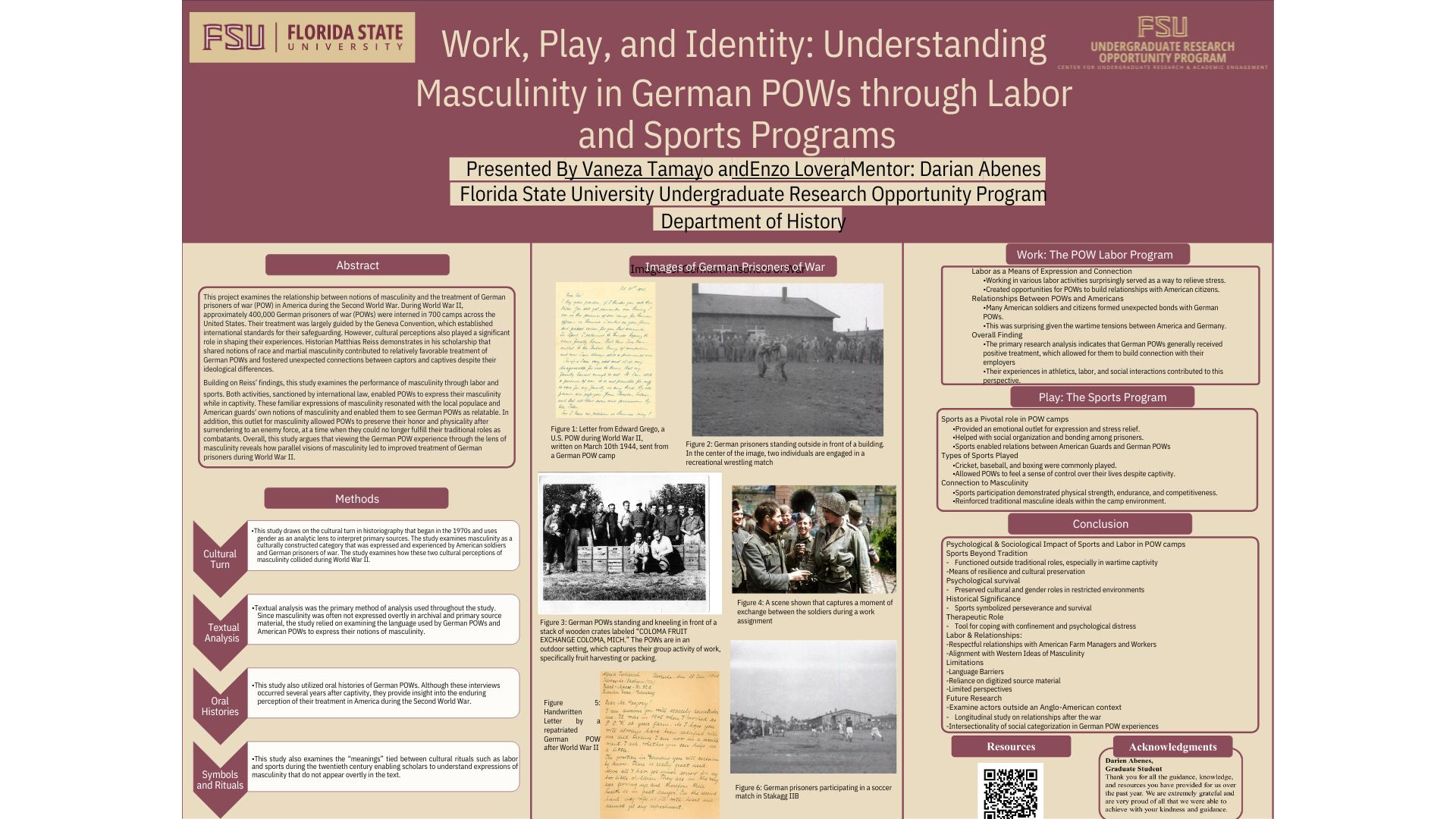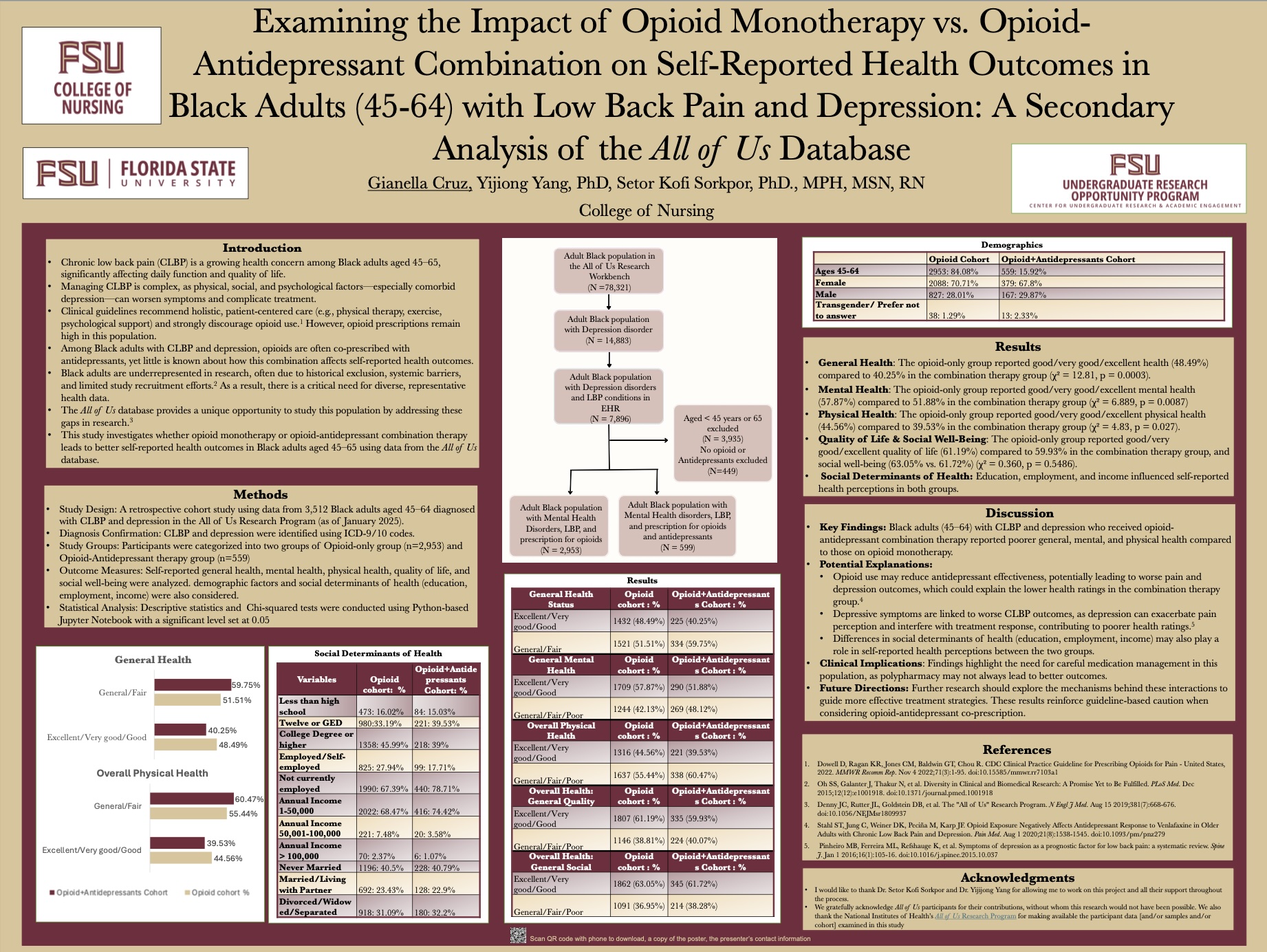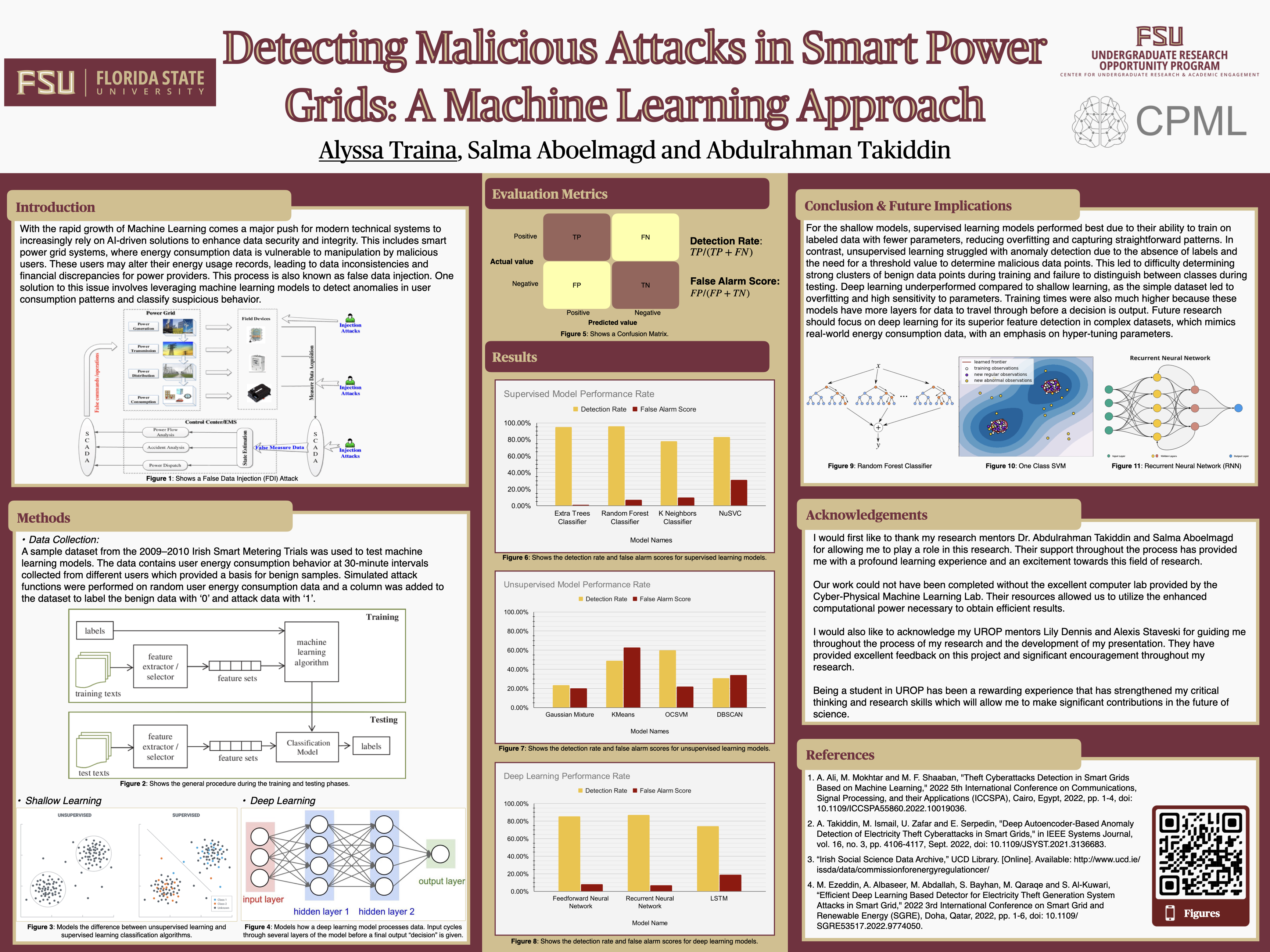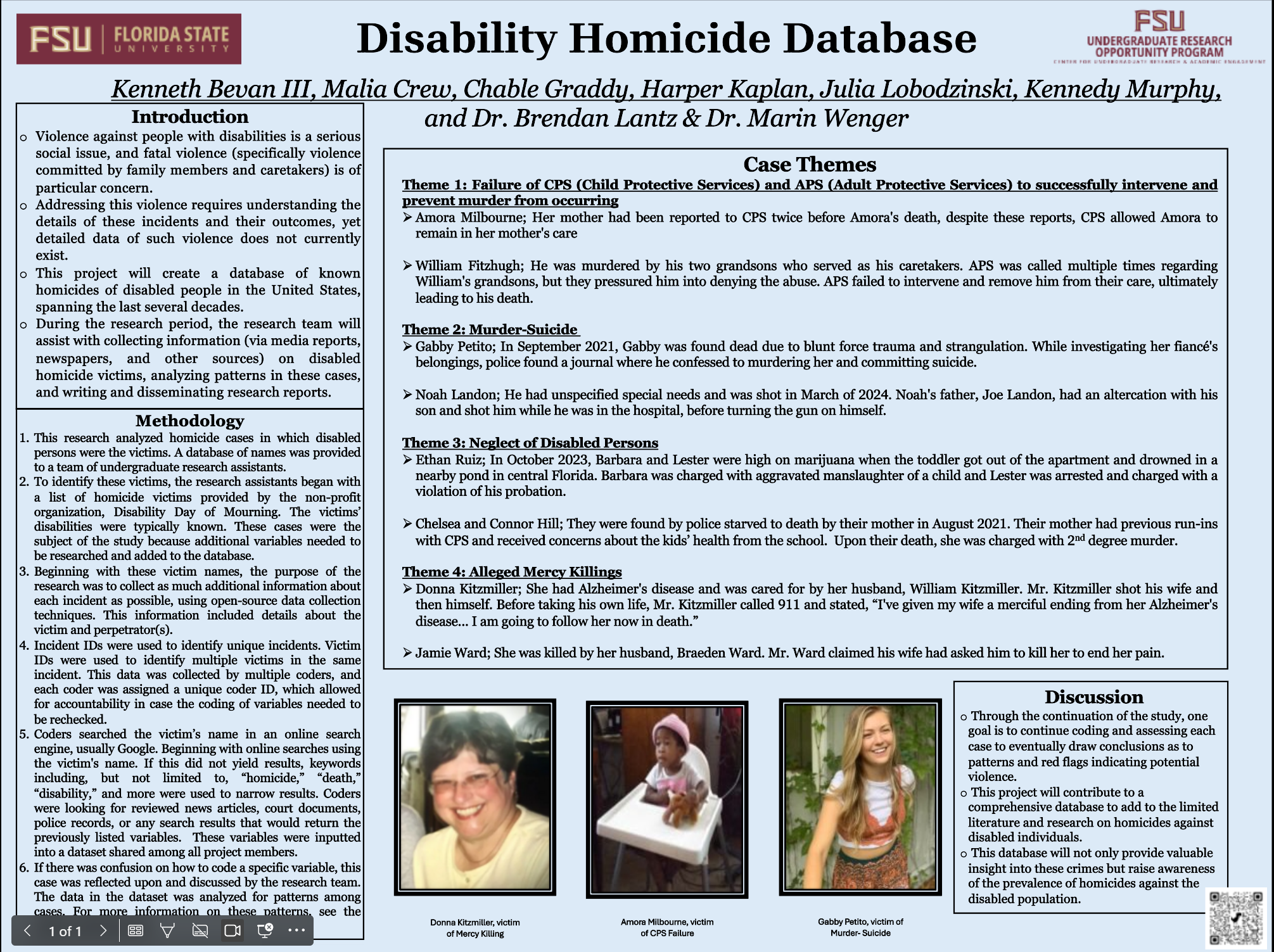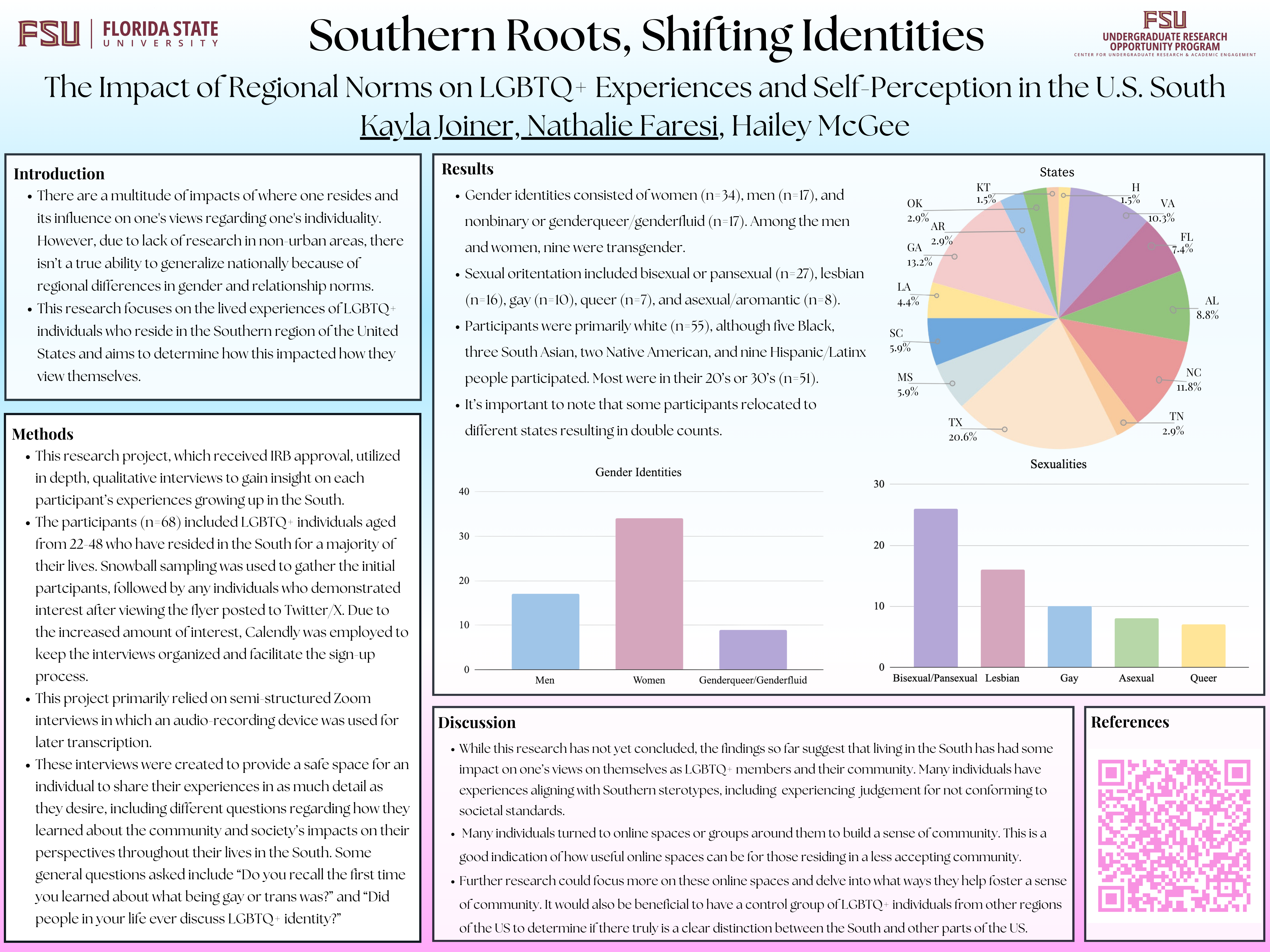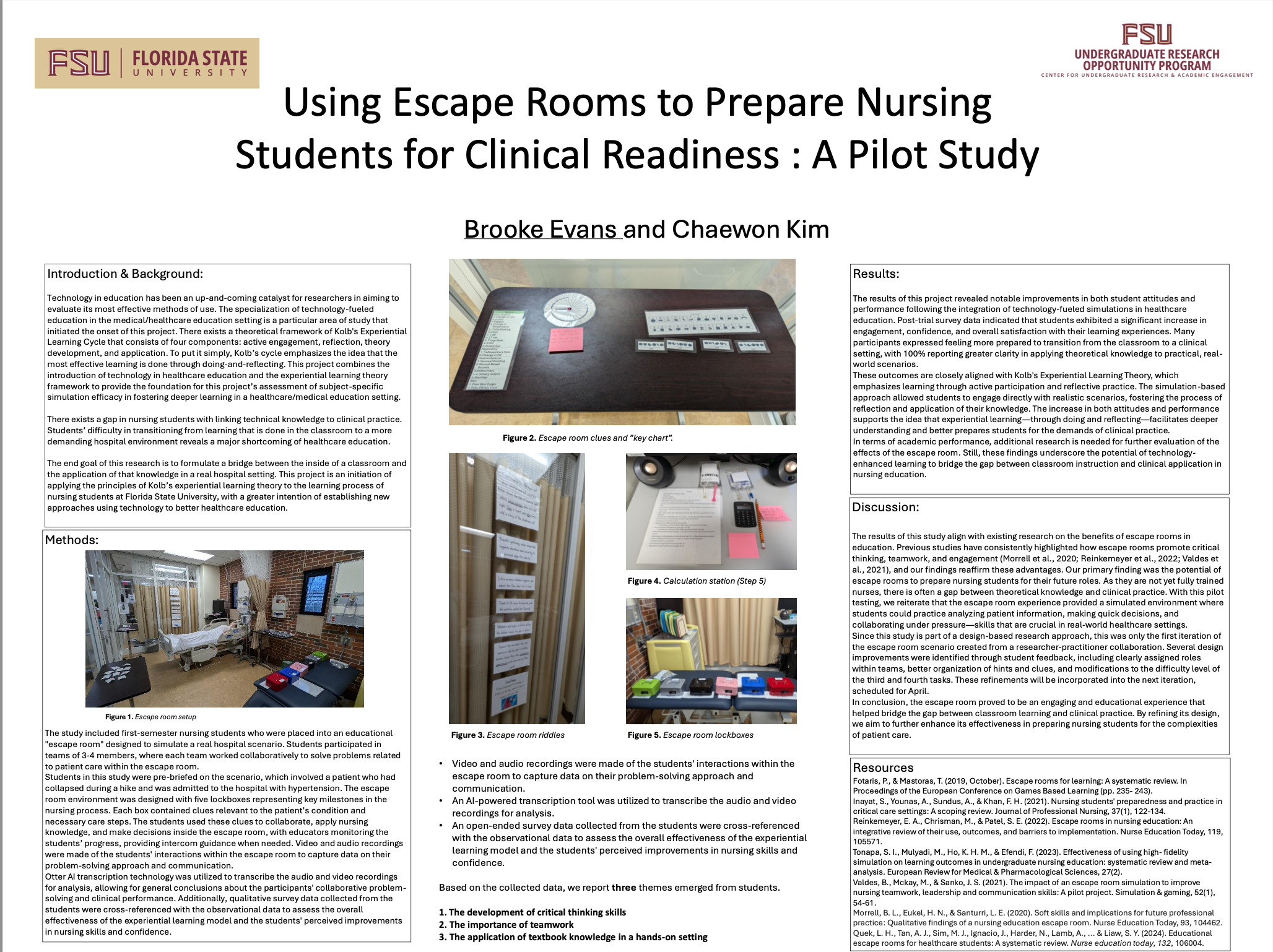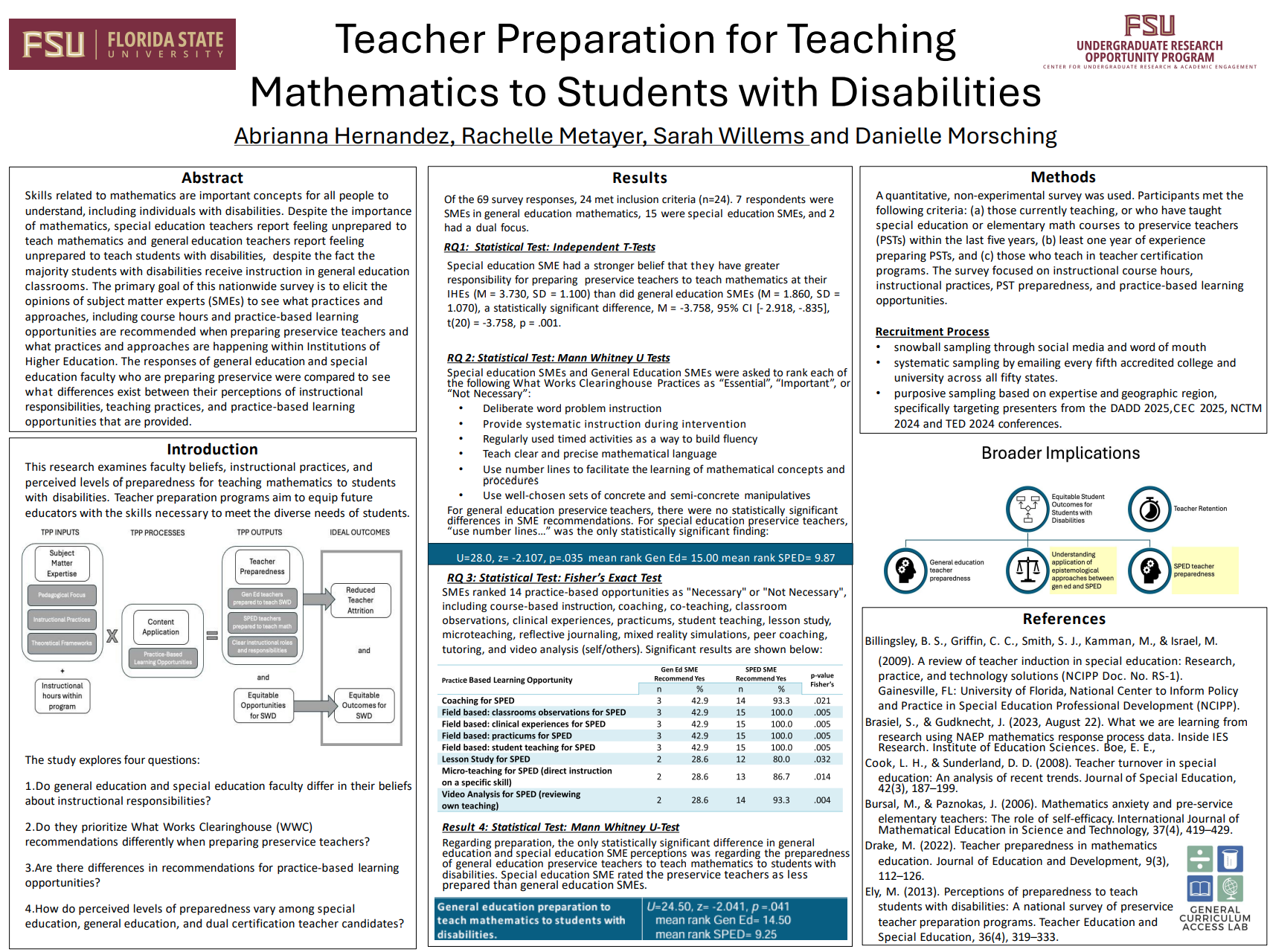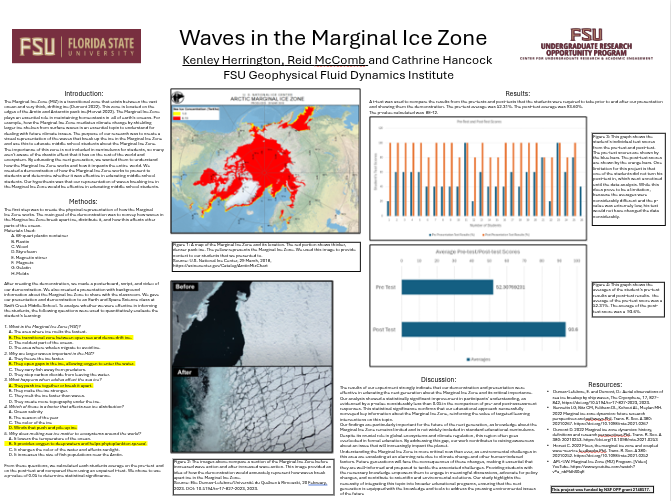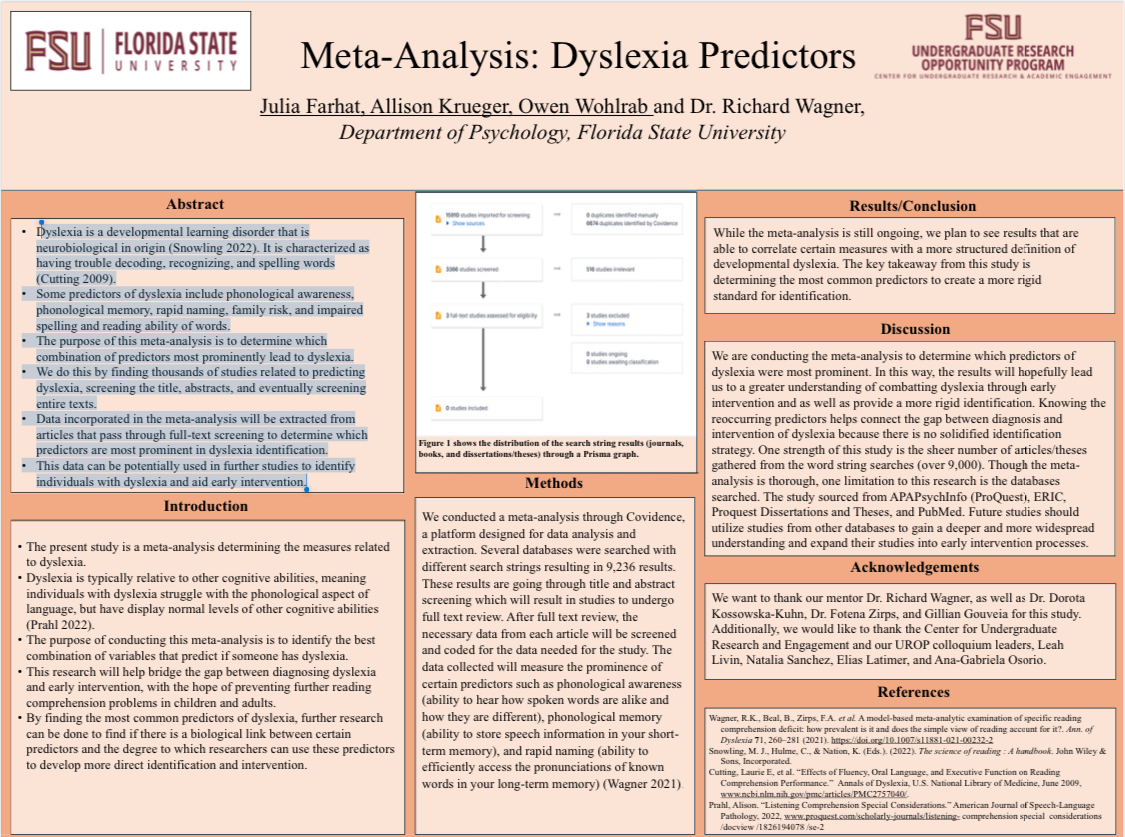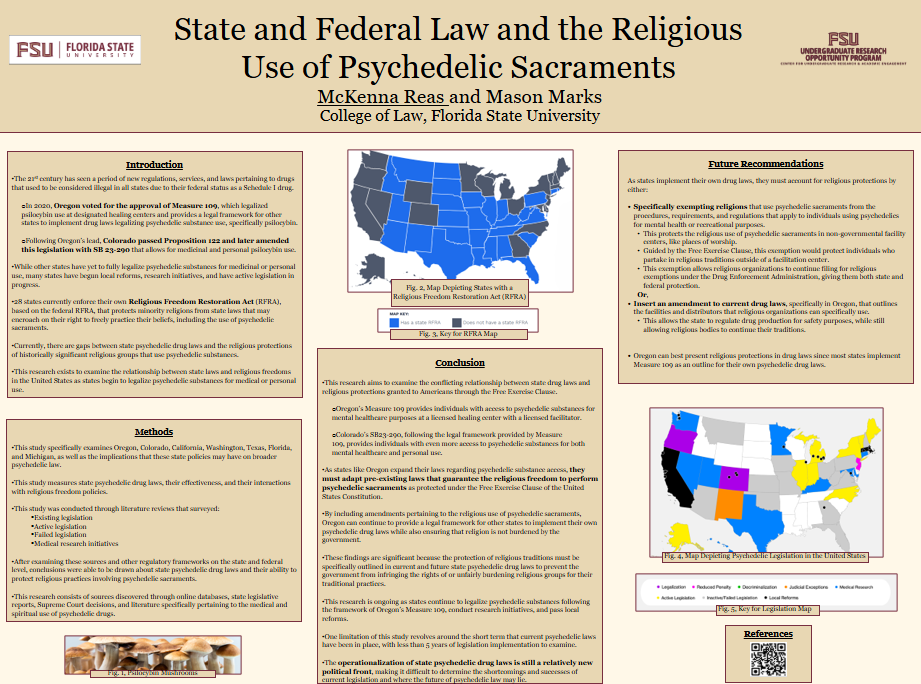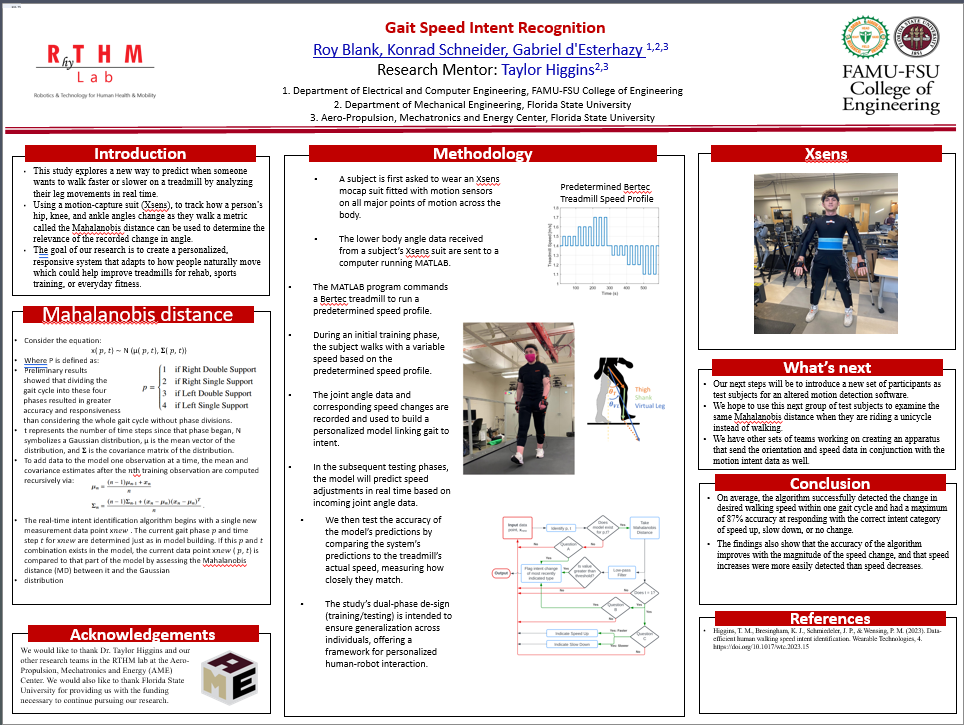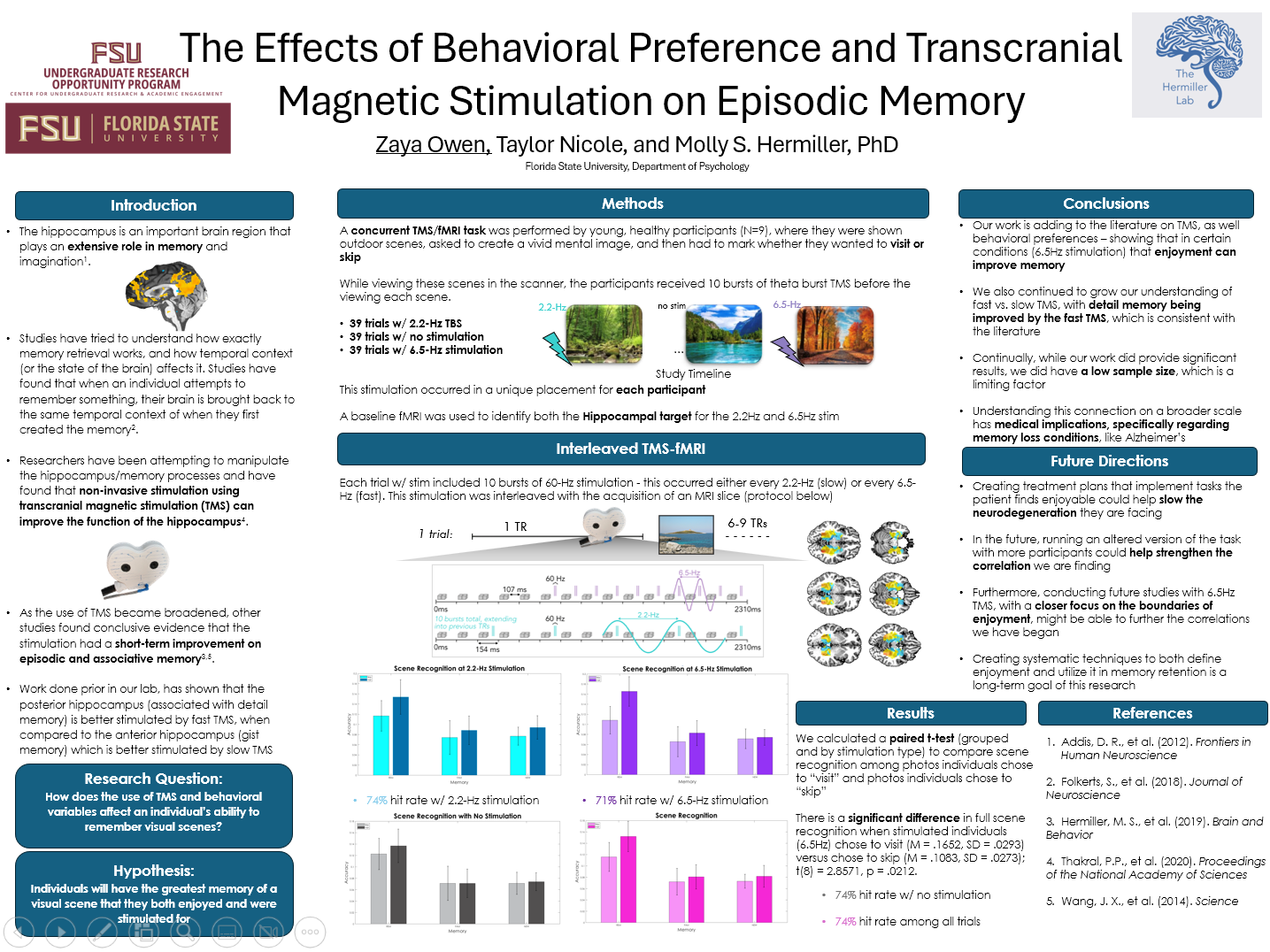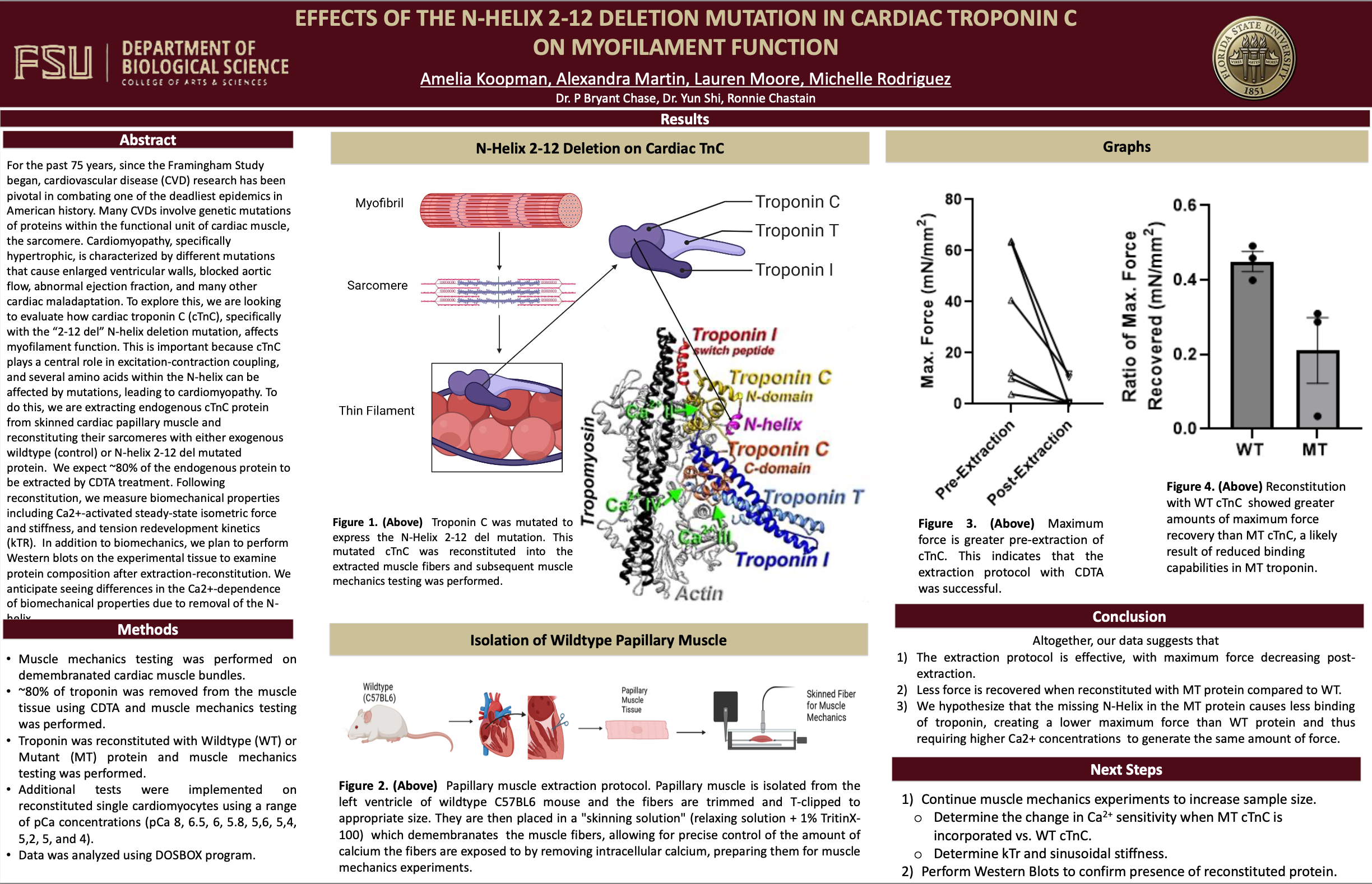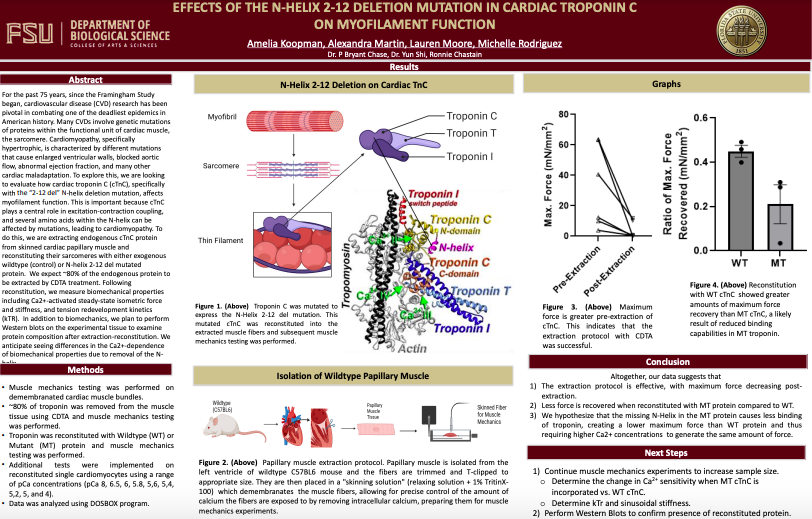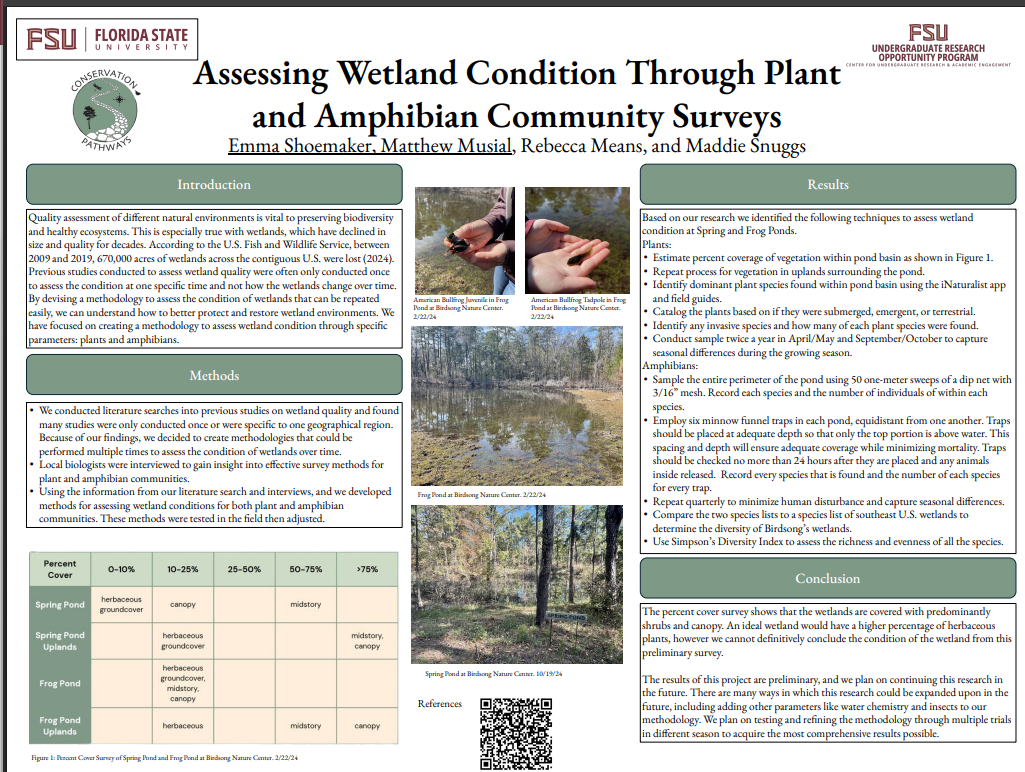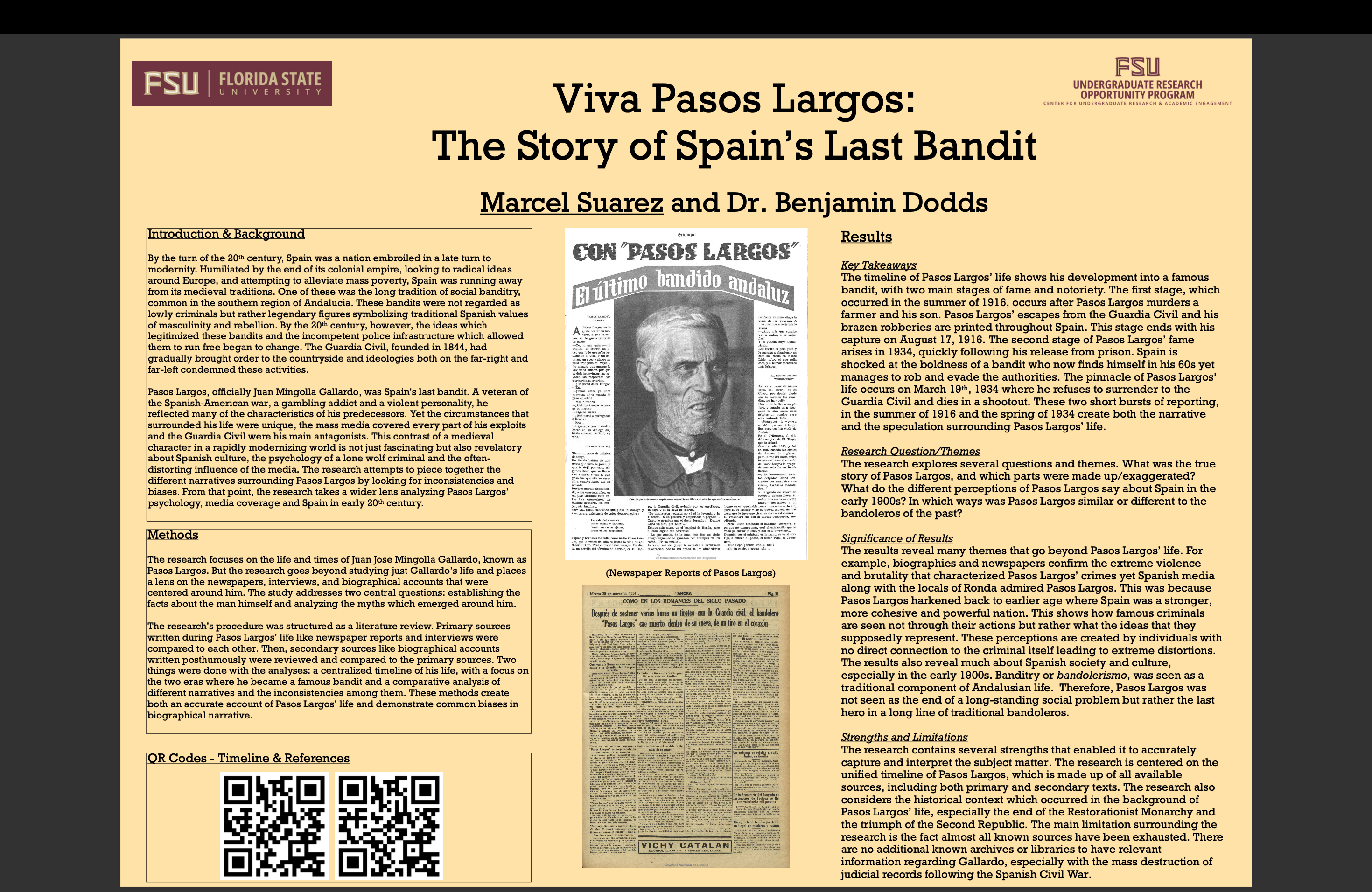Research Symposium
25th annual Undergraduate Research Symposium, April 1, 2025
Mary Sawyer Poster Session 4: 3:00 pm - 4:00 pm/ Poster #157
BIO
I am a first-year student from Miami pursuing a double-major in Editing, Writing, Media and International Affairs. I currently compete as a witness on the Undergraduate Mock Trial team and I am involved with Inter-Residence Hall Council as the elected Historian for the JRB Hall Complex. I am also passionate about studying Russian, watching international films, and taking long walks in all environments. I was intrigued by Genre Frictions as a research project because I wanted to study the relationship between fictional narratives and political activism. Participating in UROP has facilitated my engagement with editing for publication, research, and analysis and argumentation at the academic level. I plan to use these skills broadly through my undergraduate career and beyond as I move forward with my education.
Genre Frictions and Narrative Passivity: The Deconstruction and Reinforcement of Structural Violence in Environmental Justice Literature
Authors: Mary Sawyer, Dr. Rebecca BallardStudent Major: Editing, Writing, Media and International Affairs
Mentor: Dr. Rebecca Ballard
Mentor's Department: Department of English Mentor's College: College of Arts and Sciences Co-Presenters:
Abstract
The manuscript on which I worked, Genre Frictions, builds on research regarding how activists and writers contributed the environmental justice and health justice movements as they developed in the late 20th century. Previous research addresses the role of this literature in the 1990s American environmental justice movement, but Genre Frictions also investigates how the form and content of narration in the novels, and specifically their use of genre, shape their representation of the causal mechanisms of systemic environmental and health disparity and thereby mobilize political will against injustice. Systemic health injustice continues to pervade contemporary society in manners which often elude common understandings of causality—for example, with the mismanagement of the COVID-19 pandemic and its consequences. This research is relevant to understanding how literary narratives can shape political discourse, allowing us to bridge the apparent gap between interacting with art and literature and our status as political subjects. As an independent researcher, I explored the narrative treatment of disability in environmental justice literature. I focused on researching environmental justice literature from the perspective of disability studies.
Keywords: Environmental Justice, Environmentalism, Literature, Disability, Genre
25th annual Undergraduate Research Symposium, April 1, 2025
Vaneza Tamayo Poster Session 1: 9:30 am - 10:30 am/ Poster #252

BIO
Hello, I am Vaneza Tamayo! A little bit about me is that I believe I am a creative person, I reach for my goals, I am a hard worker, and I am compassionate. I am from Fort Myers, Florida, and although I am seven hours away from home, a little distance doesn't scare me from reaching my goals. I have long-term goals of becoming a veterinarian and getting into vet school, so I try my hardest to immerse myself in one-of-a-kind experiences such as the UROP program. A big reason I joined UROP is because I had a long ambition of getting involved in research here at FSU, because of this program I have checked one of my long-term goals that I wanted to experience as an undergraduate, and I am grateful for the opportunity that this program has given me. My Research interests are history, evolution, animal behavior, and medicine. I hope my UROP experience will open more doors for me that work outside my history project and allow me to gain experience in other topics I am interested in.
Work, Play, and Identity: Understanding Masculinity in German POWs through Labor and Sports Programs
Authors: Vaneza Tamayo, Darian AbnesStudent Major: Biological Sciences
Mentor: Darian Abnes
Mentor's Department: History Mentor's College: FSU Co-Presenters: Enzo Lovera
Abstract
This project examines the relationship between notions of masculinity and the treatment of German prisoners of war (POW) in America during the Second World War. During World War II, approximately 400,000 German prisoners of war (POWs) were interned in 700 camps across the United States. Their treatment was largely guided by the Geneva Convention, which established international standards for their safeguarding. However, cultural perceptions also played a significant role in shaping their experiences. Historian Matthias Reiss demonstrates in his scholarship that shared notions of race and martial masculinity contributed to relatively favorable treatment of German POWs and fostered unexpected connections between captors and captives despite their ideological differences.
Building on Reiss’ findings, this study examines the performance of masculinity through labor and sports. Both activities, sanctioned by international law, enabled POWs to express their masculinity while in captivity. These familiar expressions of masculinity resonated with the local populace and American guards' own notions of masculinity and enabled them to see German POWs as relatable. In addition, this outlet for masculinity allowed POWs to preserve their honor and physicality after surrendering to an enemy force, at a time when they could no longer fulfill their traditional roles as combatants. Overall, this study argues that viewing the German POW experience through the lens of masculinity reveals how parallel visions of masculinity led to improved treatment of German prisoners during World War II.
Keywords: German POWs
25th annual Undergraduate Research Symposium, April 1, 2025
Annie McIlroy Poster Session 3: 1:45 pm - 2:45 pm/ Poster #15
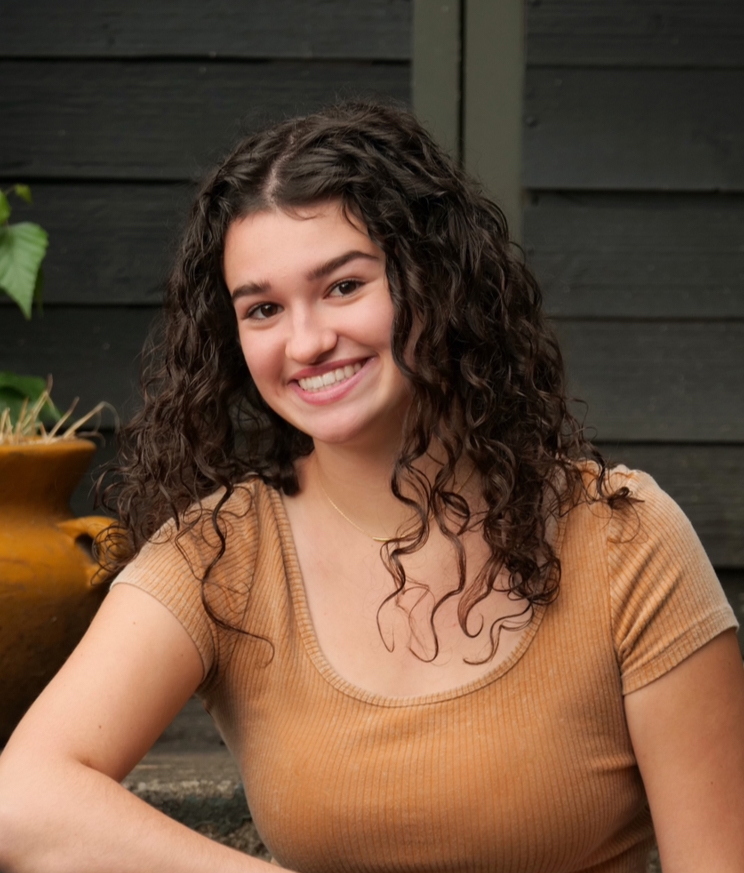
BIO
My name is Annie McIlroy and I am from Akron, Ohio! I am currently majoring in behavioral neuroscience with minors in child development, chemistry, and international affairs with plans to graduate in December of 2025. After graduating, I hope to attend medical school.
Associations among General Anxiety, Test Anxiety, Math Anxiety, and Math Achievement in Children
Authors: Annie McIlroy, Colleen GanleyStudent Major: Behavioral Neuroscience
Mentor: Colleen Ganley
Mentor's Department: Psychology Mentor's College: Arts and Sciences Co-Presenters: Caitlyn Lucy
Abstract
Children’s math achievement may be impacted by many factors, including different forms of anxiety. Math anxiety is a discomfort associated with math learning and math tasks and is a prevalent issue among children. Math anxiety in children is often linked to decreased math achievement. However, the extent to which math anxiety is distinct from or explains the relation between general anxiety and test anxiety with math achievement remains unclear. This study aims to examine the relations among general anxiety, test anxiety, math anxiety, and math achievement in elementary aged children, investigating whether math anxiety mediates the relation between general anxiety or test anxiety with math achievement. A sample of approximately 500 second-grade students were assessed using validated self-report measures of general anxiety and test anxiety, alongside a researcher adapted math anxiety scale at the beginning of the school year. They then completed a researcher developed math achievement assessment at the end of the school year. We hypothesize that general anxiety and test anxiety will negatively relate to math achievement and that math anxiety will mediate these relations. Understanding these associations may provide insight into the underlying mechanisms affecting the math success of elementary-aged students, which can inform interventions aimed at reducing anxiety-related barriers in the classroom.
Keywords: Anxiety, Math, Children
25th annual Undergraduate Research Symposium, April 1, 2025
Gianella Cruz Poster Session 3: 1:45 pm - 2:45 pm/ Poster #97
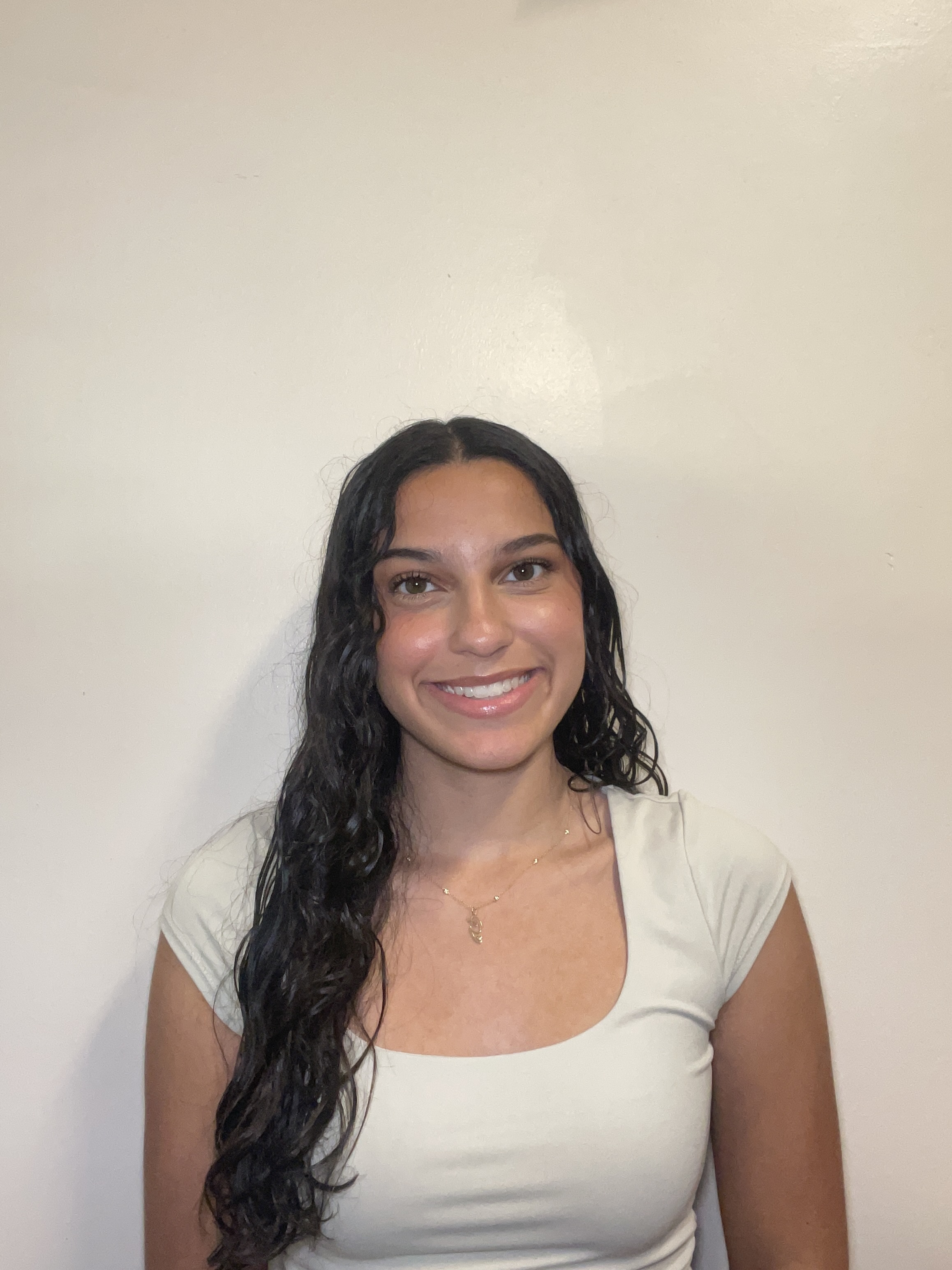
BIO
My name is Gianella Cruz, and I am a pre-nursing student from Miami, Florida. I aspire to get a master’s degree to become a Nurse Practitioner. I am passionate about health equity and interested in research that addresses the needs of under-researched and underserved populations.
Examining the Impact of Opioid Monotherapy vs. Opioid- Antidepressant Combination on Self-Reported Health Outcomes in Black Adults (45-64) with Low Back Pain and Depression: A Secondary Analysis of the All of Us Database
Authors: Gianella Cruz, Setor Kofi SorkporStudent Major: Pre-nursing
Mentor: Setor Kofi Sorkpor
Mentor's Department: College of Nursing Mentor's College: College of Nursing Co-Presenters:
Abstract
Black adults aged 45–64 experience a high burden of chronic low back pain (CLBP) and face disparities in pain management. While guidelines favor nonpharmacologic treatments, opioids remain widely used. In those with comorbid depression, opioids are often co-prescribed with antidepressants, raising concerns about increased risks such as polypharmacy, reduced treatment efficacy, and negative health outcomes. This study examines whether opioid monotherapy is associated with better self-reported health outcomes than combination therapy. This retrospective cohort study utilized data from 3,512 Black adults aged 45–64 diagnosed with CLBP and depression in the All of Us Research Program (January 2025). Diagnoses were confirmed using ICD-9/10 codes. Participants were divided into opioid-only (n=2,953) and opioid-antidepressant therapy (n=559) groups. Statistical analyses, including descriptive statistics, chi-square tests, and logistic regression models, were conducted using Python-based Jupyter Notebook, adjusting for pain severity, comorbidities, and sociodemographic factors. Preliminary findings suggest that opioid monotherapy is associated with higher self-reported health ratings than combination therapy (48% vs. 40% reporting good or better health). Participants in the combination therapy group reported higher levels of fatigue and drowsiness, which may contribute to poorer health perceptions. They also reported a higher frequency of medication side effects, including nausea and dizziness. These findings suggest that opioid-antidepressant co-prescription may be linked to poorer health outcomes in this population. While further research is needed, results support guideline-based caution regarding polypharmacy. Future studies should examine the mechanisms behind these associations to inform clinical decisions.
Keywords: chronic pain, nursing, opioids
25th annual Undergraduate Research Symposium, April 1, 2025
Jonathan Michel Poster Session 2: 10:45 am - 11:45 am/ Poster #134
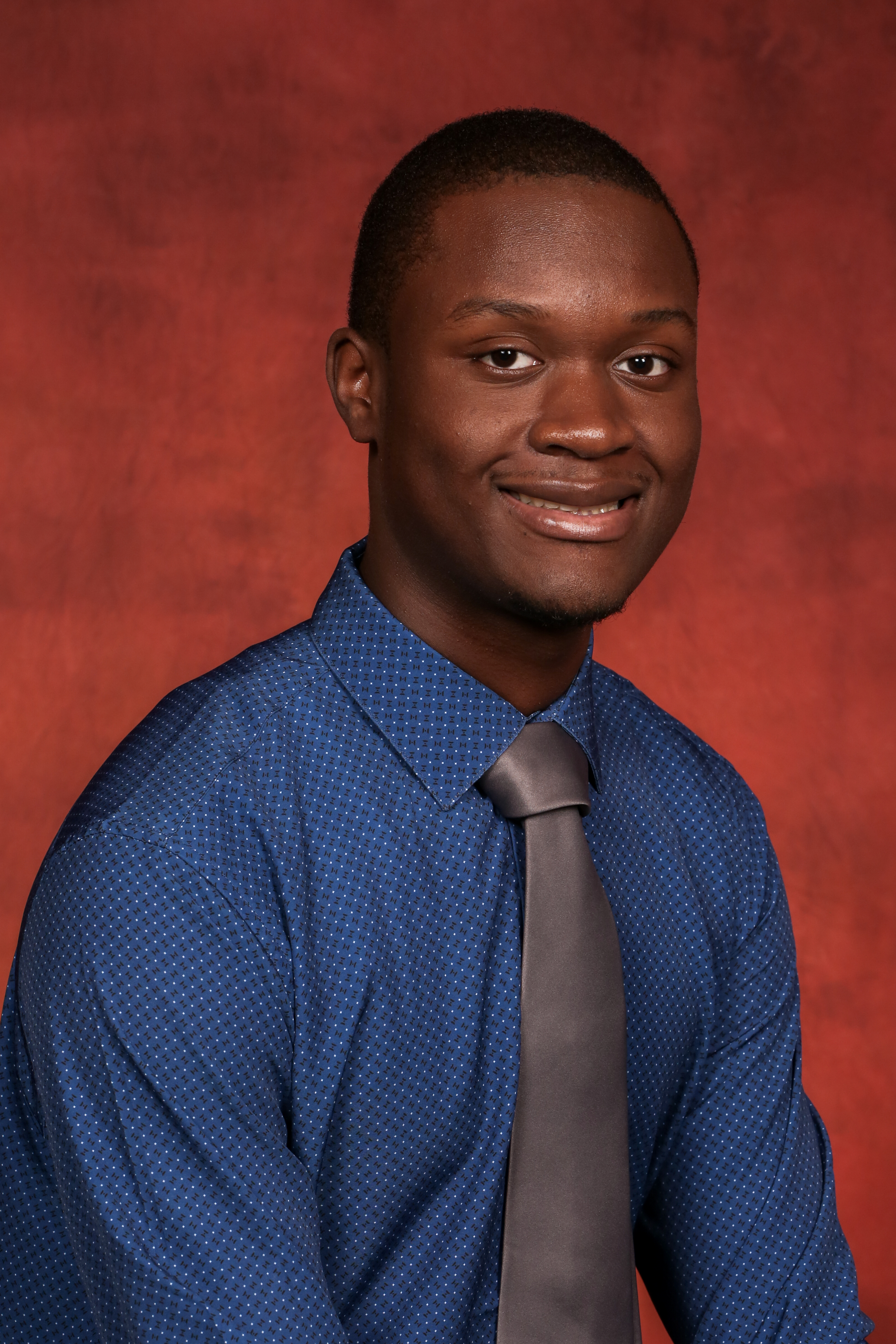
BIO
Jonathan Michel is a third-year Cell and Molecular Neuroscience major at Florida State University. Originally from Pembroke Pines, Florida, he developed a strong interest in brain health and cognitive aging through personal experiences with Alzheimer’s disease in his family. His research focuses on the relationship between nutrition and vascular dementia, with the broader aim of developing interventions that support healthy aging. As a participant in the Undergraduate Research Opportunity Program (UROP), Jonathan is preparing to launch a Directed Individual Study examining psychosocial and behavioral strategies to improve late-life health outcomes. He plans to attend medical school and pursue a career as a physician, integrating clinical practice with neuroscience research to help prevent and treat neurodegenerative diseases.
Impact of Macronutrients, Micronutrients, and Minerals in Risk Factors of Vascular Dementia
Authors: Jonathan Michel, Dr. Julia Sheffler, PhDStudent Major: Cell and Molecular Neuroscience
Mentor: Dr. Julia Sheffler, PhD
Mentor's Department: Center for Translational Behavioral Sciences Mentor's College: Florida State University College of Medicine Co-Presenters: Reza Noori, Sarvika Dasari and Viviana Gutierrez Camary
Abstract
Vascular dementia (VaD) is a growing global health concern, exacerbated by an aging population and its associated economic and social burdens. While there is no cure, prevention strategies targeting modifiable risk factors—particularly diet—have gained significant attention. Macronutrients, micronutrients, and minerals play crucial roles in cognitive function and vascular health, yet their specific mechanisms remain unclear. Dietary patterns such as the Mediterranean and ketogenic diets have shown the potential to reduce dementia risk by improving metabolic and cardiovascular health. This study examines the relationship between specific dietary components and VaD risk factors in high-risk older adults through a 10-week pilot clinical trial. Thirty-one participants (aged 55–85 years, MoCA ≥16) were randomized into four intervention groups: a Mediterranean diet or a Mediterranean ketogenic diet, with or without a support group. Assessments included dietary tracking (Nutritionix), blood biomarker analysis, gut microbiome composition, and cognitive testing using the NIH Toolbox Cognition Battery. Macronutrient ratios, antioxidants, omega fatty acids, and essential minerals (magnesium, potassium, calcium, selenium, zinc) were analyzed alongside vascular risks. This study aims to identify how specific dietary components are associated with change in executive functioning, blood pressure, and cholesterol across a 10-week dietary intervention. These findings will contribute to a broader understanding of dietary interventions for mitigating vascular dementia risk in aging populations.
Keywords: Vascular Dementia, Diet, Cognitive Function, Macronutrients, Micronutrients
25th annual Undergraduate Research Symposium, April 1, 2025
Alyssa Traina Poster Session 1: 9:30 am - 10:30 am/ Poster #33

BIO
Hello, my name is Alyssa Traina and I am originally from Titusville, Florida. I am currently a second-year student pursuing a Bachelor of Science in Computer Science with the hopes of becoming a software engineer. My campus involvements include the Association for Computing Machinery, Women in Computer Science, and the Project Development Club. I am also currently a software engineering intern for Raide and J.P. Morgan Chase.
Detecting Malicious Attacks in Smart Power Grids: A Machine Learning Approach
Authors: Alyssa Traina, Dr. Abdulrahman TakiddinStudent Major: Computer Science B.S.
Mentor: Dr. Abdulrahman Takiddin
Mentor's Department: Department of Electrical and Computer Engineering Mentor's College: College of Engineering Co-Presenters:
Abstract
Many smart power grids that collect information about user household energy consumption are vulnerable to attacks that lead to data discrepancies and financial deficits. The aim of this research is to identify the most effective Machine Learning models that can be utilized to analyze false data injection attacks being performed on user data and classify anomalies as malicious. These models may then be used to automate the security process in smart power grids and detect subtle patterns that may be overlooked by people. Predominantly two types of Machine Learning models were examined in this research: shallow learning models and deep learning models. The shallow learning models were further subdivided into supervised learning models and unsupervised learning models. Based on an analysis of model algorithms, candidate models were selected from each category to be trained on a simple experimental dataset to classify malicious users. Performance metrics such as detection rate, accuracy, f1 score, and false alarm score were used to assess the models’ results. This research found that, overall, supervised shallow learning models efficiently discovered malicious patterns, while there was a drop in performance for the unsupervised shallow learning models and deep learning models due to the simplicity of the dataset and the need for labels for accurate training. The results indicate that future research on more complex and larger datasets should be conducted in the field of deep learning due to the ability of the models to interpret complex features, which is desirable for real-world user energy consumption data.
Keywords: Machine Learning, False Data Injection Attacks, Smart Grid Security, Cyber-Physical Systems, Binary Classification
25th annual Undergraduate Research Symposium, April 1, 2025
Malia Crew Poster Session 1: 9:30 am - 10:30 am / Poster #167
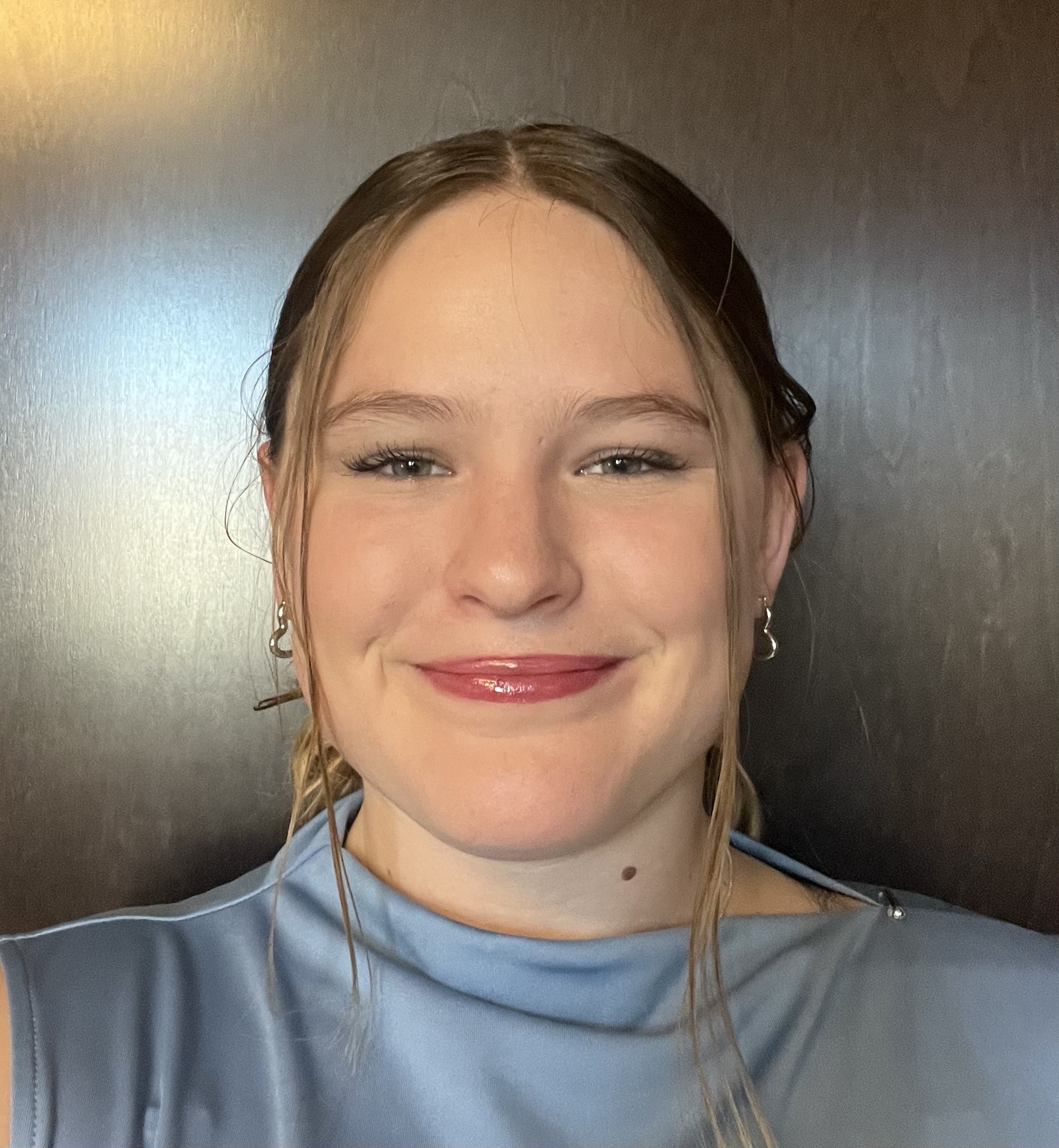
BIO
Hi! I'm Malia Crew. I am a current freshman at FSU that will be graduating in Fall 2026. I am from St. Petersburg Florida and a fourth generation student of FSU. I enjoy the swimming, playing beach volleyball, and escape rooms. My majors are criminology and psychology and I plan on looking for a job in law enforcement in the future. I love research and plan to stay with the disability homicide database until I graduate. For research in the future I would be interested in improving jail conditions in Florida or looking for ways to improve the safety of law enforcement officers.
Disability Homicide Database
Authors: Malia Crew, Dr. Brendan LantzStudent Major: Criminology, Psychology
Mentor: Dr. Brendan Lantz
Mentor's Department: Hate Crime Mentor's College: Florida State University Co-Presenters: Kenneth Bevan III, Malia Crew, Chable Graddy, Harper Kaplan, Julia Lobodzinski, Kennedy Murphy
Abstract
Violence against individuals with disabilities is a significant social issue, with fatal incidents—specifically those committed by family members or caretakers—being of particular concern. Addressing this violence requires a comprehensive understanding of these incidents; however, detailed data on such cases is currently lacking. This research project aims to fill this gap by developing a database of known homicides of disabled individuals in the United States over several decades. Researchers compiled data using open source data collection techniques, including collecting data from media reports, police records, social media, and obituaries, coding cases based on variables such as age, location, race, gender, type of violence, criminal history, and warning signs. The goal was to reach data saturation, ensuring the most complete picture of each case. This dataset enables pattern analysis through data analytics and research reports, providing patterns that can inform strategies to protect individuals with disabilities. Key indicators, such as prior criminal history or past child protective services involvement, can help law enforcement identify and intervene in high-risk situations before violence occurs. In the next phase, this project will continue gathering data and refining its approach seeking out common themes to better understand and prevent violence against individuals with disabilities. Collaboration with policymakers and law enforcement will play a crucial role in strengthening protective measures and addressing systemic gaps. Through ongoing analysis and public awareness efforts, this research aims to drive meaningful change and build a safer, more just society for individuals with disabilities.
Keywords: Disability Homicide Database
25th annual Undergraduate Research Symposium, April 1, 2025
Nathalie Faresi Poster Session 1: 9:30 am - 10:30 am / Poster #155

BIO
Hi, my name is Nathalie Faresi, and I'm a sophomore studying Behavioral Neuroscience with a minor in Chemistry on the Pre-Med track. Originally from Delray Beach, FL, I’m passionate about exploring how neuroscience, psychology, and medicine influence one another, and focused on building a well-rounded education that looks at issues from as many different angles as possible. I’m eager to expand my research experience throughout my undergraduate years, not just to gain experience, but to contribute to meaningful discoveries!
Southern Roots, Shifting Identities: The Impact of Regional Norms on LGBTQ+ Experiences and Self-Perception in the U.S. South
Authors: Nathalie Faresi, Hailey McGeeStudent Major: Behavioral Neuroscience
Mentor: Hailey McGee
Mentor's Department: Sociology Mentor's College: Social Sciences and Public Policy Co-Presenters: Kayla Joiner
Abstract
There are a multitude of different impacts of where one resides and its influence on their views regarding their individuality. This research focused primarily on the lived experiences of LGBTQ+ individuals who reside in the Southern region of the United States and aimed to determine how this impacted how they view themselves. The methods used for this research study include semi-structured interviews which consisted of a one-on-one interview between the interviewer and individual where a set of questions were asked to each participant, including follow-up questions that the interviewer felt necessary. Some general questions asked include “Do you recall the first time you learned about what being gay or trans was?” and “Did people in your life ever discuss LGBTQ+ identity?” While this research has not yet concluded, the findings so far suggest that living in the South has had some impact on one’s views on themselves as LGBTQ+ members and their community. Many individuals have experiences aligning with Southern stereotypes, including experiencing judgement for not conforming to societal standards. As a result, individuals tended to turn to online spaces or groups around them to build a sense of community. This is a good indication of how useful online spaces can be for those residing in a less accepting community and further research could focus more on these online spaces and delve into what ways they help foster a sense of community.
Keywords: LGBTQ+, South, Identity
25th annual Undergraduate Research Symposium, April 1, 2025
Brooke Evans Poster Session 1: 9:30 am - 10:30 am/ Poster #47

BIO
I’m Brooke Evans, a nursing major with a minor in child development at Florida State University! I’m originally from Tampa, Florida, and I come from a long line of educators and healthcare professionals—almost all the women in my family are teachers or nurses. This legacy has sparked my passion for both education and healthcare, and it’s what drives my enthusiasm for this project. I am incredibly passionate about my pursuit of my career and my studies during my time in nursing school. My goal is to foster deeper learning for myself and other fellow students in healthcare education and make the learning process more engaging and practical, especially for future nurses!
Using Escape Rooms to Prepare Nursing Students for Clinical Readiness: A Pilot Study
Authors: Brooke Evans, Chaewon KimStudent Major: Nursing
Mentor: Chaewon Kim
Mentor's Department: Instructional Systems and Learning Technologies Mentor's College: College of Education Co-Presenters: N/A
Abstract
- Technology in education has been an up-and-coming catalyst for researchers in aiming to evaluate the most effective methods of use. In the medical and healthcare education setting, this particular area of study initiated the onset of this project.
- This study combines this technological approach with the principles of the experiential learning theory, also known as Kolb’s cycle. This educational theory discusses how concrete experiences contribute to the learning process. In the case of this project, this theory was applied by facilitating experiential engagement and collaboration in nursing-simulated escape room challenges to address existing gaps between nursing education and student clinical readiness.
- The escape rooms allowed students to immerse themselves in a real- world problem-solving scenario, reflecting the emphasis of the experiential learning theory on the involvement of learners and the situated nature of knowledge. In addition, this research also examined the role of pre-briefing and de-briefing through evaluation of post-survey data, supported by the idea that maximum retention requires meaningful reflection between the experience and further understanding.
- The results highlight the importance of structured experiential learning using technology-based simulation in the nursing education setting and reflect the importance of incorporating a window of reflection in enhancing student performance. We suggest further research to refine and validate this technological model of experiential learning in a nursing-educational context.
Keywords: Nursing, Education, Healthcare
25th annual Undergraduate Research Symposium, April 1, 2025
Abrianna Hernandez Poster Session 1: 9:30 am - 10:30 am / Poster #263
BIO
Abrianna Hernandez is a second-year student, majoring in Management Information Systems, from Miami, Florida, and is researching teacher preparation for teaching mathematics to students with disabilities. By working with her research mentor and fellow researchers, this work aims to investigate the teaching methods used to instruct mathematics to students with special needs. Looking ahead, she is heading towards a career encompassing areas in accounting, administration, and technology.
Teacher Preparation for Teaching Mathematics to Students with Disabilities
Authors: Abrianna Hernandez, Danielle MorschingStudent Major: Management Information Systems
Mentor: Danielle Morsching
Mentor's Department: Education, Health, and Human Sciences Mentor's College: Education, Health, and Human Sciences Co-Presenters: Rachelle Metayer and Sarah Willems
Abstract
Skills related to mathematics, such as budgeting, are important concepts for all people to understand. The comprehension of mathematics is related to the quality of teaching. With poor teaching methods, many students struggle to understand mathematics, including students with disabilities. The primary goal of this study is to investigate the teaching methods used to teach students with disabilities. To do so, we identified accredited institutions in all 50 states with education departments. Each person we noted from the list was sent a survey. Survey responses were then organized into tables to identify patterns between responses. Patterns observed are still being analyzed, so no results are reported. Effective teaching methods observed in the results will help current and future educators foster a well-supported environment for students. Thus, creating a more inclusive and effective teaching environment.
Keywords: Mathematics Instruction, Students with Disabilities, Teacher Preparation
25th annual Undergraduate Research Symposium, April 1, 2025
Kenley Herrington Poster Session 1: 9:30 am - 10:30 am / Poster #218

BIO
My name is Kenley Herrington and I am a sophomore double-majoring in Environmental Science and Secondary Education at Florida State University. I am originally from Birmingham, Alabama, but I have lived in Tampa, Florida for the past few years. Living by the ocean sparked my passion for environmental science and is what pushed me to pursue a career in the field. My future career goal is to be an environmental scientist and work in conservation, specifically with the ocean.
Waves in the Marginal Ice Zone
Authors: Kenley Herrington, Cathrine HancockStudent Major: Environmental Science/Secondary Education
Mentor: Cathrine Hancock
Mentor's Department: Geophysical Fluid Dynamics Institute Mentor's College: Florida State University Co-Presenters: Reid McComb
Abstract
The purpose of our research was to create a physical representation of how waves in the Marginal Ice Zone break up sea ice and then present this demonstration to students between 6th and 8th grade. We investigated this to determine how effective our demonstration was at educating students about the Marginal Ice Zone. This project is relevant to everyone in our community because it is of high importance that people begin to understand and spread knowledge of what goes on in our oceans. Through examining the ice in the Arctic Ocean, we can see how drastic changes affect the entire world. By educating the youth, we aim to spread a clear and impactful message to those around us of these issues. Our methods were to create a physical demonstration that the students could see to visualize how the Marginal Ice Zone works. We did this by using various objects and tools such as wood, a plastic container, a magnetic stirrer, magnets, gelatin, Styrofoam, and molds. From presenting our demonstration to middle school students and testing their knowledge with a pre-test and post-test, we found that our demonstration did increase their knowledge on the Marginal Ice Zone. We used a t-test to analyze our data and found that our results were statistically significant. With our data being statistically significant, we can conclude that presenting the topic with a hands-on demonstration was effective in the students' understanding of the project.
Keywords: waves, ice, education, Marginal Ice Zone
25th annual Undergraduate Research Symposium, April 1, 2025
Daisy Perez Poster Session 4: 3:00 pm - 4:00 pm/ Poster #64
BIO
My name is Daisy Perez and I'm a sophomore from West Palm Beach, FL. I'm currently majoring in Biological Sciences on the pre-med track, driven by a deep passion for improving healthcare and making a difference in the lives of others. I am an ambitious and hardworking student who values both academic excellence and personal growth.
As part of the Undergraduate Research Opportunities Program (UROP), I am working on a project focused on on the intersectionality between aging, disabilities, and workplace accommodations. This experience has allowed me to apply my curiosity and commitment to healthcare in a meaningful way, exploring how research can help solve real-world problems. UROP has also provided me with the chance to collaborate with dedicated mentors and fellow students, fostering a community of intellectual curiosity and support.
In addition to my academic and research pursuits, I am passionate about using my skills to make a difference in healthcare. I strive to develop a deeper understanding of the challenges patients face and am committed to using my experiences to improve access to quality care. My journey as a pre-med student is fueled by my desire to contribute to the healthcare field and support the well-being of others.
Fostering Workplace Supports and Success Among Older Workers: A Scoping Review
Authors: Daisy Perez, Shengli DongStudent Major: Biological Sciences
Mentor: Shengli Dong
Mentor's Department: Educational Psychology and Learning Systems Mentor's College: College of Education Co-Presenters:
Abstract
The aging demographic in the workforce continues to grow and holds significant implications at individual, familial, and societal levels. Legal frameworks such as the Americans with Disabilities Act and the Rehabilitation Act of 1973 have been put in place to call for advocacy in the workplace. Yet, barriers persist for those with disabilities, especially the aged. This study addresses critical issues such as workplace participation to foster an inclusive workplace for older workers. A literature review was performed after selecting articles surrounding the scope of accommodations for older workers in the workplace. Using the FSU Library database and Zotero to find and store/sort relevant articles and remove any duplicates, we were able to compile a list of pertinent articles, which we further narrowed down using our selection criteria: involving working participants aged 50 and older, accommodation request, usage and provision, and a published empirical study from January 1, 1990 to December 1, 2023. Aging workers may receive accommodations, including flexible schedules, assistive programs, and longer absences from work. Challenges, including misconceptions and limited awareness about disabilities, were identified as barriers for workers seeking accommodations. Our results were consistent with that of previous research, and intersectionality frameworks show how factors such as age, race, and gender can shape one’s experience, allowing us to explore lived experiences further. However, relying on literature limits the study’s scope, as gaps in research and potential biases in published studies may affect our findings.
Keywords: Disability, Accommodations, Aging, Workplace
25th annual Undergraduate Research Symposium, April 1, 2025
Owen Wohlrab Poster Session 2: 10:45 am - 11:45 am/ Poster #234
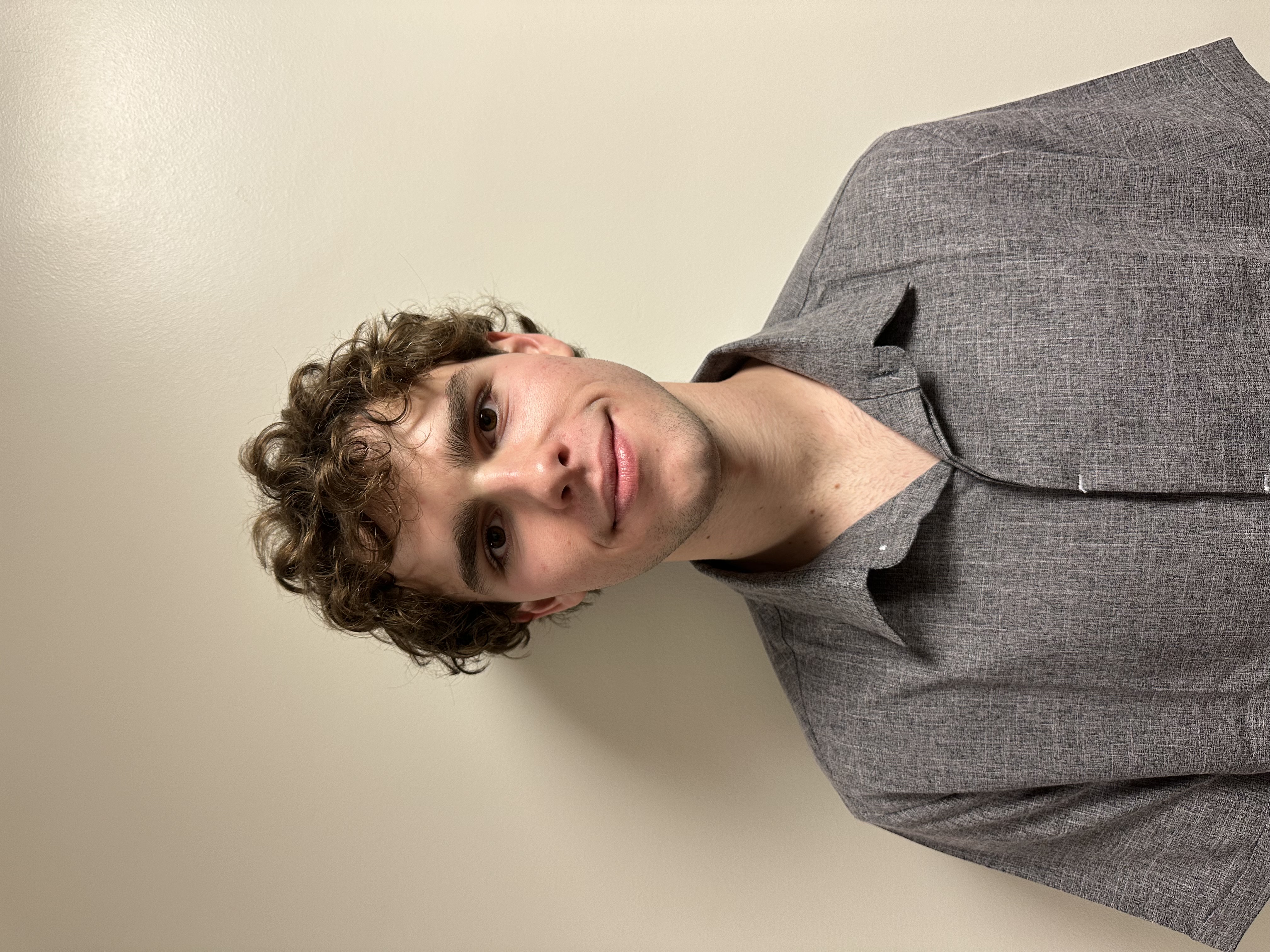
BIO
I am majoring in Cell and Molecular Neuroscience here at FSU. I am currently pre-med, and I hope to go to medical school to pursue neurology.
Dyslexia Predictors
Authors: Owen Wohlrab, Richard WagnerStudent Major: Cell and Molecular Neuroscience
Mentor: Richard Wagner
Mentor's Department: Psychology Mentor's College: College of Arts and Sciences Co-Presenters: Julia Farhat, Allison Krueger
Abstract
Dyslexia is a developmental learning disorder that is
neurobiological in origin (Snowling 2022). It is characterized as
having trouble decoding, recognizing, and spelling words
(Cutting 2009).
• Some predictors of dyslexia include phonological awareness,
phonological memory, rapid naming, family risk, and impaired
spelling and reading ability of words.
• The purpose of this meta-analysis is to determine which
combination of predictors most prominently lead to dyslexia.
• We do this by finding thousands of studies related to predicting
dyslexia, screening the title, abstracts, and eventually screening
entire texts.
• Data incorporated in the meta-analysis will be extracted from
articles that pass through full-text screening to determine which
predictors are most prominent in dyslexia identification.
• This data can be potentially used in further studies to identify
individuals with dyslexia and aid early intervention.
Keywords: Dyslexia, neurobiological, meta-analysis
25th annual Undergraduate Research Symposium, April 1, 2025
McKenna Reas Poster Session 3: 1:45 pm - 2:45 pm/ Poster #198
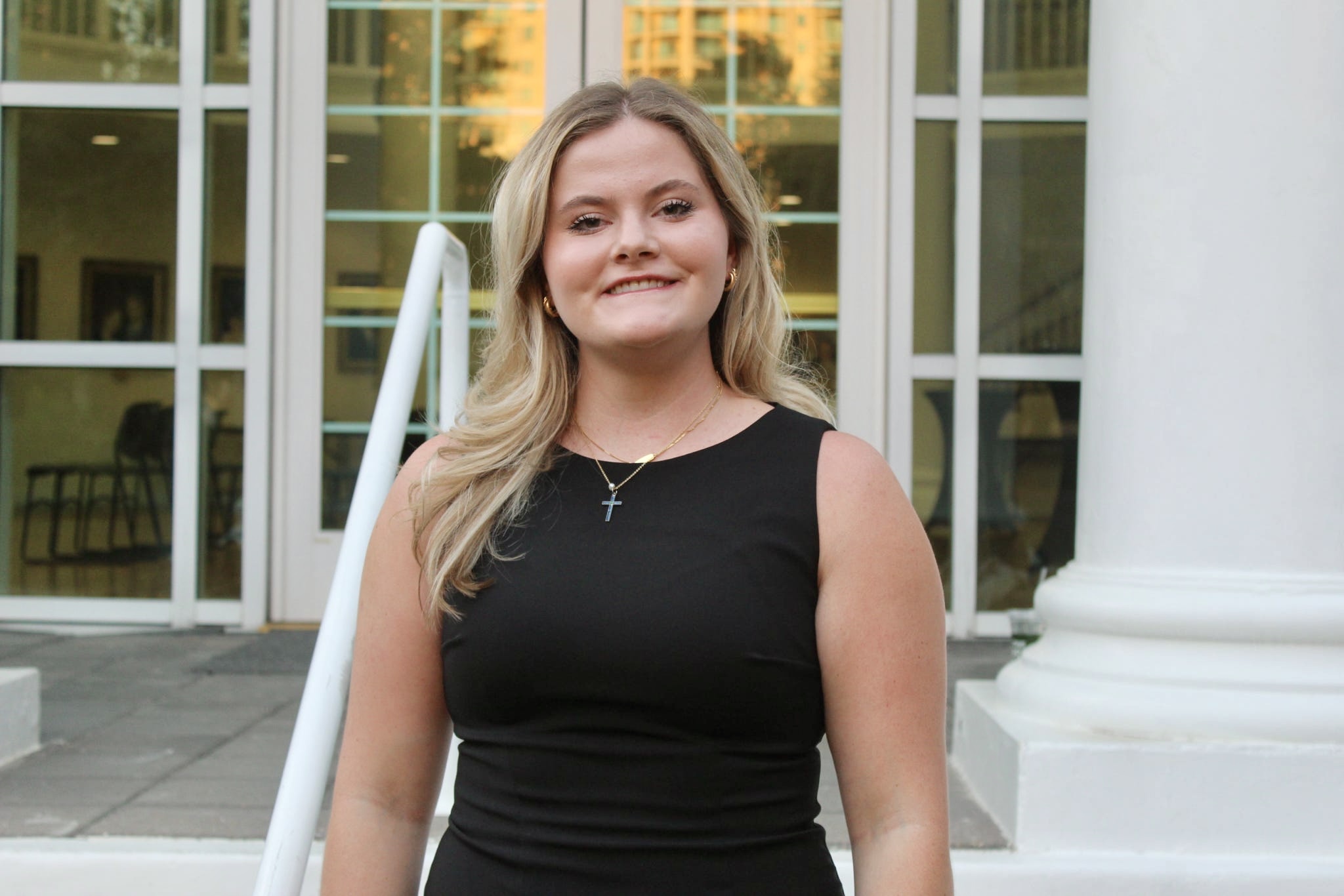
BIO
Hi! My name is McKenna, and I am a second-year student double majoring in Political Science and History from Dunwoody, Georgia. Some of my current academic interests are American history, analyses of US Supreme Court decisions, and domestic policies following the Cold War. Following graduation, I plan to attend law school to pursue a career in law, specifically military and constitutional law. Currently, I am involved in Alpha Chi Omega and Phi Alpha Delta on campus. I also serve as a University Ambassador representing Florida State University to prospective students. Off-campus, some of my interests include Atlanta Braves baseball, learning new recipes, and participating in City Church's SALT Company.
State and Federal Law and the Religious Use of Psychedelic Sacraments
Authors: McKenna Reas, Mason MarksStudent Major: Political Science and History
Mentor: Mason Marks
Mentor's Department: Law Mentor's College: College of Law Co-Presenters:
Abstract
This project analyzes the relationship between state psychedelic drug laws and religious freedoms in the United States. Oregon and Colorado have decriminalized psilocybin through state law for use at approved healing centers with the assistance of a licensed facilitator through Measure 109 and Proposition 122. However, psilocybin is still considered a Schedule I drug federally, creating tensions between new state laws and federal authority. Because these new laws fail to outline proper procedures relating to the use of psychedelic sacraments for religious purposes, there is a threat to the free exercise of communities using these sacraments. This project was conducted through literature reviews of current legislation, proposed and failed legislation, and other literature sources that reviewed these new drug laws. Preliminary findings demonstrate that, as the legal framework surrounding access to psychedelic substances becomes more prevalent, there must be additional guidelines that protect the religious use of psychedelic sacraments. The lack of clarity between state and federal procedures posits the safety of religious freedom directly between a state and federal attempt to garner authority over the future of psychedelic substance use. Future recommendations for psychedelic drug law include the addition of guidelines that address this position, guaranteeing religious access to psychedelic substances as protected by both state and federal laws. By understanding the implications of access to psychedelic substances in states like Colorado and Oregon, this project contributes to the broader field by suggesting future policies to provide psilocybin services to those in need, while also protecting religious freedoms.
Keywords: Law, Psychedelic Sacraments, State Law
25th annual Undergraduate Research Symposium, April 1, 2025
Gabriel d'Esterhazy Poster Session 2: 10:45 am - 11:45 am/ Poster #150
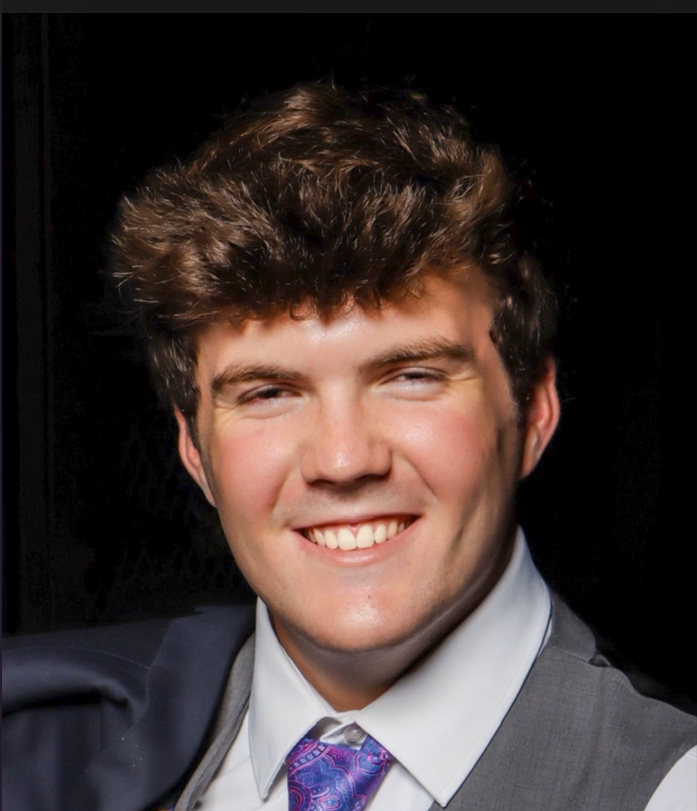
BIO
My name is Gabriel d'Esterhazy and I am a Sophomore computer engineer. I am looking to hopefully work in the field of advanced neural prosthetics and other assistive devices that interpret and act upon biometric data.
Gait Speed Intent Recognition
Authors: Gabriel d'Esterhazy, Dr. Taylor HigginsStudent Major: Computer Engineering
Mentor: Dr. Taylor Higgins
Mentor's Department: Mechanical Engineering Mentor's College: Florida State University Co-Presenters: Konrad Schneider, Roy Blank
Abstract
This study explores a new way to predict when someone wants to walk
faster or slower on a treadmill by analyzing their leg movements in real
time. Using a motion-capture suit (Xsens), to track how a person’s hip,
knee, and ankle angles change as they walk a metric called the Maha-
lanobis distance can be used to determine the relevance of the recorded
change in angle. These angles are sent to a computer running MATLAB,
which commands a Bertec treadmill to run a predetermined speed profile.
During an initial training phase, the subject walks under a variable speed
protocol, with joint angle data and corresponding speed changes recorded
to build a personalized model linking gait to intent. In the subsequent
testing phase, the model predicts speed adjustments in real time based
on incoming joint angle data. We test accuracy by comparing the sys-
tem’s predictions to the treadmill’s actual speed, measuring how closely
they match. The goal is to create a personalized, responsive system that
adapts to how people naturally move, which could help improve treadmills
for rehab, sports training, or everyday fitness. The study’s dual-phase de-
sign (training/testing) ensures generalization across individuals, offering
a framework for personalized human-robot interaction.
Keywords: Gait speed, intent, treadmill
25th annual Undergraduate Research Symposium, April 1, 2025
Zaya Owen Poster Session 4: 3:00 pm - 4:00 pm/ Poster #93

BIO
I am a behavioral neuroscience major, who is predicted to graduate in the spring of 2026! I am from Orlando, Fl and moved to Tallahassee, Fl during my freshman year. I started working with the Hermiller Lab in the fall of 2024 for my UROP project and I am excited to work with them through the next school year, as well. I am very interested in the study of memory as well as the modulation of it using non-invasive Transcranial Magnetic Stimulation and look forward to continuing my study of it. Eventually, I do hope to attend graduate school and earn a PhD in neuroscience.
The Effects of Behavioral Preference and Transcranial Magnetic Stimulation on Episodic Memory
Authors: Zaya Owen, Molly HermillerStudent Major: Behavioral Neuroscience
Mentor: Molly Hermiller
Mentor's Department: Psychology Department Mentor's College: College of Arts and Sciences Co-Presenters:
Abstract
The hippocampus is the major brain region behind memory formation, and it has been found to be enhanced using transcranial magnetic stimulation (TMS). Our research aims to understand how behavioral preferences affect one’s memory, specifically when an individual receives this non-invasive stimulation. We scanned nine participants in an fMRI with each being shown 117 visual outdoor scenes. Short trains of TMS were delivered immediately prior to scene onset. For a third of trials, the TMS was delivered in a slow theta (2.2-Hz) pattern; for another third of trials, TMS was delivered in a fast theta (6.5-Hz) pattern; the final trials had no stimulation prior to scene presentation. Stimulation type was randomly interleaved throughout. While viewing each scene, the participants were instructed to create a mental image, and then select whether they would visit or skip. Afterwards, participants completed a recognition test, to gauge memory. We analyzed participants’ mean performance overall, as well as for each stimulation condition. Through a paired t-test, we saw that participants were significantly more likely to remember a location they had chosen to visit, while also having received 6.5-Hz stimulation. This shows how behavioral preferences can enhance the memory, especially when paired with TMS. There is little research on how behavioral preferences affect the hippocampus, and our results add to the literature by showing stronger recognition when enjoyment and 6.5-Hz stimulation occur. Understanding the connection between behavioral preferences and memory can have broad impacts, especially clinically for memory loss disorders.
Keywords: Memory, Neuroscience, TMS, Behavior
25th annual Undergraduate Research Symposium, April 1, 2025
Alexandra Martin Poster Session 3: 1:45 pm - 2:45 pm/ Poster #9
BIO
I am a senior at FSU majoring in Biology with a minor in Chemistry. I am also on the pre-medical track and will be applying this cycle. I have been doing research in Dr. Chase's Lab for 6 semesters and this is my second time presenting at the FSU research symposium! At FSU, I am the treasurer of Alpha Epsilon Delta, member of Phi Beta Kappa, and a Captain in Dance Marathon. I am a Certified Medical Assistant and interned at Patients First as well as abroad at Clinica Sorolla. During my gap year I plan to work as a Medical Assistant, continue research, and volunteer.
Effects of the N-Helix 2-12 Deletion Mutation in Cardiac Troponin C on Myofilament Function
Authors: Alexandra Martin, Dr. P. Bryant ChaseStudent Major: Biological Sciences
Mentor: Dr. P. Bryant Chase
Mentor's Department: Biological Science Mentor's College: College of Arts and Sciences Co-Presenters: Amelia Koopman, Lauren Moore, Michelle Rodriguez
Abstract
For the past 75 years, since the Framingham Study began, cardiovascular disease (CVD) research has been pivotal in combating one of the deadliest epidemics in American history. Many CVDs involve genetic mutations of proteins within the functional unit of cardiac muscle, the sarcomere. Cardiomyopathy, specifically hypertrophic, is characterized by different mutations that cause enlarged ventricular walls, blocked aortic flow, abnormal ejection fraction, and many other cardiac maladaptation. To explore this, we are looking to evaluate how cardiac troponin C (cTnC), specifically with the “2-12 del” N-helix deletion mutation, affects myofilament function. This is important because cTnC plays a central role in excitation-contraction coupling, and several amino acids within the N-helix can be affected by mutations, leading to cardiomyopathy. To do this, we are extracting endogenous cTnC protein from skinned cardiac papillary muscle and reconstituting their sarcomeres with either exogenous wildtype (control) or N-helix 2-12 del mutated protein. We expect ~80% of the endogenous protein to be extracted by CDTA treatment. Following reconstitution, we measure biomechanical properties including Ca2+-activated steady-state isometric force and stiffness, and tension redevelopment kinetics (kTR). In addition to biomechanics, we plan to perform Western blots on the experimental tissue to examine protein composition after extraction-reconstitution. We anticipate seeing differences in the Ca2+-dependence of biomechanical properties due to removal of the N-helix.
Keywords: Troponin, Cardio Myopathy, Mutations, Muscle Mechanics.
25th annual Undergraduate Research Symposium, April 1, 2025
Amelia Koopman Poster Session 2: 10:45 am - 11:45 am/ Poster #9
BIO
I am a third-year undergraduate student who is on a pre-PA track. I have been doing research in Dr. Chase's lab for 5 semesters now, working on a variety of projects on muscle mechanics.
Effects of the N-Helix 2-12 Deletion Mutation in Cardiac Troponin C on Myofilament Function
Authors: Amelia Koopman, Dr. P. Bryant ChaseStudent Major: Biological Science
Mentor: Dr. P. Bryant Chase
Mentor's Department: Department of Biological Science Mentor's College: College of Arts and Sciences Co-Presenters: Alexandra Martin, Lauren Moore, and Michelle Rodriguez
Abstract
For the past 75 years, since the Framingham Study began, cardiovascular disease (CVD) research has been pivotal in combating one of the deadliest epidemics in American history. Many CVDs involve genetic mutations of proteins within the functional unit of cardiac muscle, the sarcomere. Cardiomyopathy, specifically hypertrophic, is characterized by different mutations that cause enlarged ventricular walls, blocked aortic flow, abnormal ejection fraction, and many other cardiac maladaptation. To explore this, we are looking to evaluate how cardiac troponin C (cTnC), specifically with the “2-12 del” N-helix deletion mutation, affects myofilament function. This is important because cTnC plays a central role in excitation-contraction coupling, and several amino acids within the N-helix can be affected by mutations, leading to cardiomyopathy. To do this, we are extracting endogenous cTnC protein from skinned cardiac papillary muscle and reconstituting their sarcomeres with either exogenous wildtype (control) or N-helix 2-12 del mutated protein. We expect ~80% of the endogenous protein to be extracted by CDTA treatment. Following reconstitution, we measure biomechanical properties including Ca2+-activated steady-state isometric force and stiffness, and tension redevelopment kinetics (kTR). In addition to biomechanics, we plan to perform Western blots on the experimental tissue to examine protein composition after extraction-reconstitution. We anticipate seeing differences in the Ca2+-dependence of biomechanical properties due to removal of the N-helix.
Keywords: troponin, cardiomyopathy, mutation, muscle mechanics, calcium
25th annual Undergraduate Research Symposium, April 1, 2025
Emma Shoemaker Poster Session 2: 10:45 am - 11:45 am/ Poster #80
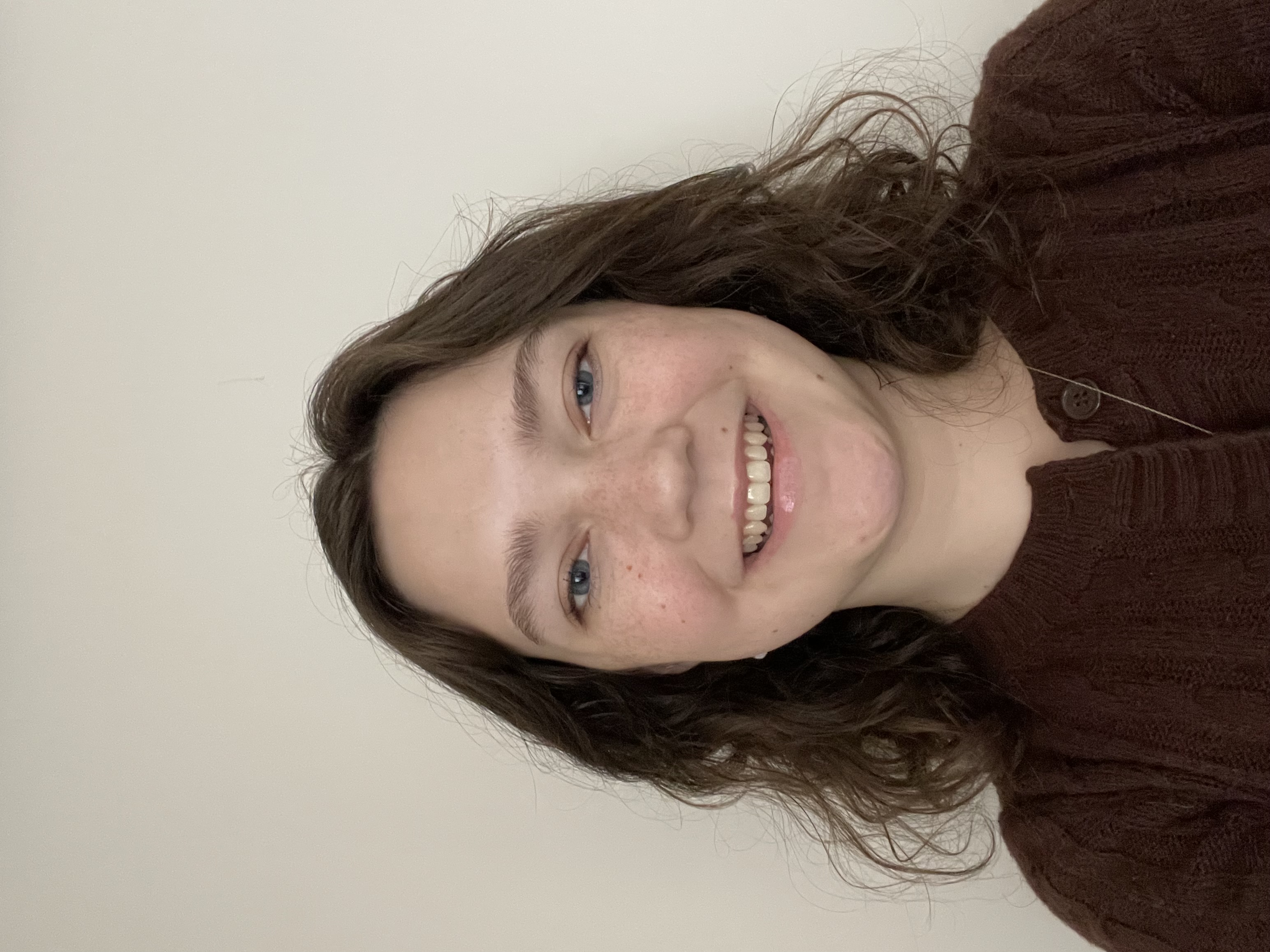
BIO
My name is Emma Shoemaker. I am a sophomore majoring in Biochemistry from Satellite Beach, FL. I am on the executive board of the Yoga Club at FSU and participate as a cellist in the University Sinfonia Orchestra. I am researching with Conservation Pathways, studying how to assess wetland conditions through plant and amphibian communities. In the future, I plan to work in the field. Working with Conservation Pathways has given me many opportunities to enter the field, and I love it.
Assessing Wetland Condition Through Plant and Amphibian Community Surveys
Authors: Emma Shoemaker, Rebecca MeansStudent Major: Biochemistry
Mentor: Rebecca Means
Mentor's Department: N/A Mentor's College: N/A Co-Presenters: Matthew Musial
Abstract
Assessing the quality of different environments is essential to preserving natural habitats, especially wetlands, which have been declining for decades. By creating a methodology for evaluating the quality of a wetland, it is possible to monitor its condition and significantly contribute to the restoration and preservation of the environment. We focused on constructing a method to assess wetland quality through the plant and amphibian communities found at Birdsong Nature Center. We conducted a literature search to gather various approaches to evaluating wetland quality before concentrating on plants and amphibians. We cataloged the plants found in the wetland and classified them based on frequency, proximity to water, and vegetation layer. This classification helps us identify the diversity and species richness of the plants in the wetland and determine whether they are native or invasive. To assess the amphibian species in the wetlands, we employed dip-netting techniques, conducting 50 one-meter sweeps around each pond and setting funnel traps at six equidistant spots along the pond's edge. We placed the traps at an appropriate depth to facilitate easy retrieval while preventing overheating of the amphibians (~ 0.5 m). Using each method, we recorded the species and number of amphibians found in each pond. The results of our research will provide valuable insights into the health of wetlands and provide clear direction for what is needed to maintain or improve the quality of the wetlands.
Keywords: Environmental Science, Wetlands, Conservation
25th annual Undergraduate Research Symposium, April 1, 2025
Marcel Suarez Poster Session 1: 9:30 am - 10:30 am/ Poster #166
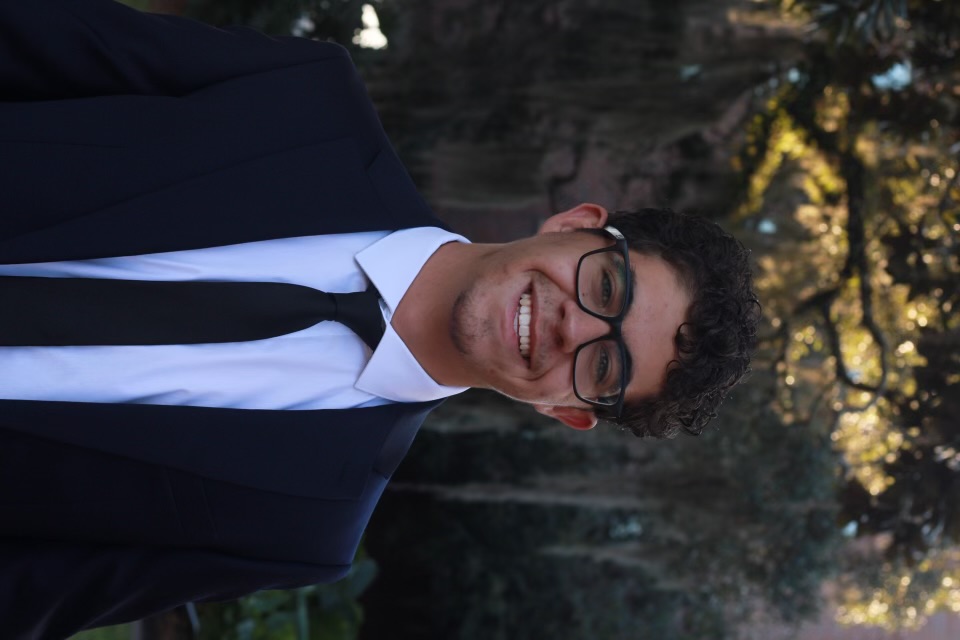
BIO
I am Marcel, a first-generation college student from Cape Coral, Florida. Currently, I am in my first-year at Florida State University and honored to participate Undergraduate Research Opportunity Program.
At Florida State, I am pursuing dual degrees in History and Philosophy. Within history, my intellectual interests are centered around the French Revolution and Modern Latin America. Within philosophy, I am especially curious about epistemology.
Outside of the classroom, I am passionate about student leadership, community service, and spending time in nature.
After my time at Florida State, I aspire to pursue a career in law.
Viva Pasos Largos: The Story of Spain's Last Bandit
Authors: Marcel Suarez, Dr. Benjamin DoddsStudent Major: History, Philosophy
Mentor: Dr. Benjamin Dodds
Mentor's Department: History Mentor's College: Arts & Sciences Co-Presenters:
Abstract
What was the story of Spain’s last bandit? The story of Juan Mingolla Gallardo, known as Pasos Largos, is a complex mix of sources, whether rumors, legends, reports or interviews. Initially, newspaper reports published during Pasos Largos’ life were analyzed. These were compared to secondary biographies and narratives published posthumously. These reviews were condensed into a timeline of Pasos Largos’ life. Pasos Largos’ exploits occurred within a crucial era of transition for Spanish society. The Spanish media and public, aware of this transition, felt both fascination and nostalgia for Pasos Largos. This led to a high degree of romanticization and exaggeration in most narratives concerning Pasos Largos. The results reveal much about how criminals are romanticized and converted into legendary figures. It also demonstrates the central role journalistic media coverage takes in this process.
Keywords: History, Spain, Criminology


